 By Pepper Parr By Pepper Parr
February 22, 2014
BURLINGTON, ON.
When they brought things to a closer on Thursday we had a CURRENT budget of $134,339,651 agreed upon at the Standing Committee and a tax increase of 3.9%. Staff had asked for a tax increase of 4.3%
Council may whittle down the staff budget request when they resume budget deliberations early in March. At that time they get to decide what they want to do with the $2.7 million surplus – money not spent in 2013. The finance staff call these “retained savings”.
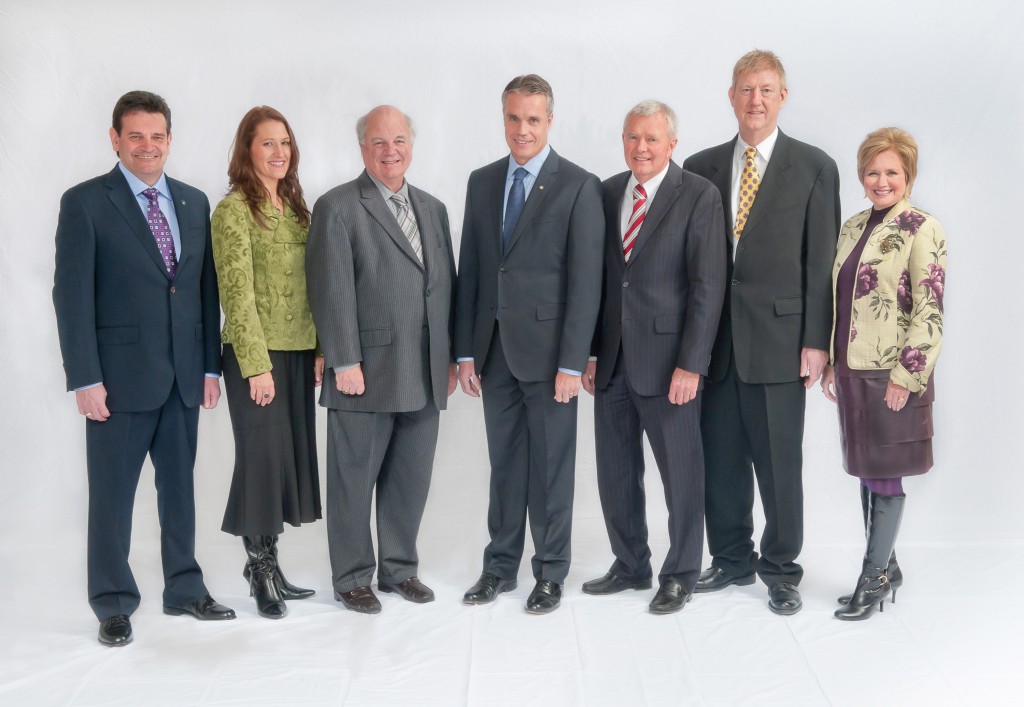 Photoshopping at its very best – the Significant Seven have never got along as much as this photograph would suggest. Several of then can’t stand one another. Mayor has said he would be quite happy to see them all re-elected. What has council done so far? The Cultural Manager was off the table, the Museums of Burlington got the contract person onto the staff roster. The Economic development people got their money but there were some strings attached.
An assistant supervisor for school crossing guards wasn’t approved but the Heritage Burlington property tax rebate did get the green light it was looking for. The Performing Arts Centre is going to get a closer look.
Bus cleaners were going to get $65,000 a year but they would be doing other work as well
Community Development Halton did get the $85,000 they were seeking (they got the same amount last year) but Councillor Taylor had to promise that he would not be asking for the same amount of money next year.
Of the 47 items that council members wanted to discuss – less than 20 got covered – so there is quite a lot of ground to cover.
On Monday the 24th, Council meets as the Development and Infrastructure committee.
Tuesday they meet as the Community and Corporate Services committee.
Thursday they do a significant session as a Committee of the Whole and focus on just where we are with the Economic Development Corporation – which is, as one real estate professional in the city put it a “disastrous embarrassment”. The economic development chicken has finally come home to roost.
The first week of March council meets on the 4th to complete the budget review and hopefully approve the document and set the tax rate for 2014.
For some reason the budget agendas this year have had the feel of a bit of a hustle to them. Usually a Standing Committee meets and recommends a budget, the public gets a few days to read, review and reflect on the document and if there are serious concerns people can delegate at the Council meeting that will approve the budget.
This year the Standing Committee will turn itself into a Council meeting and pass the budget on the spot. We don’t see much community engagement in that process. For Councillors who are up for re-election one would think they would be a little more solicitous and ensure the public gets a chance to voice their opinions. Guess you are all going to have to wait to make your opinion known on election day – October 27th.

 By Pepper Parr By Pepper Parr
February 21, 2014
BURLINGTON, ON.
There isn’t going to be a Cultural Manager in Burlington during 2014 – perhaps in 2015, but a Standing Committee just didn’t see a compelling case for hiring a new person for a job that wasn’t as clearly defined as it could have been.
The arts and culture community brought its existence to the surface – the city learned a lot more about who they were, what they are and what they do. Their lobbying efforts blew hot and cold. They certainly pulled the Mayor into their circle – but that wasn’t enough.
Staff, particularly general manager Kim Phillips, who is the lead on culture in the city, didn’t do all that much to support the creation of the position.
Council seemed to feel that a full-time cultural planner was enough for now and would revisit the needs of the cultural community next year.
 What was nascent and budding – has been stunted at the administration level. It is going to be up to the artists to create whatever structure is needed. What the city will see is various initiatives – and there is some very solid work being done by individual artists, but people who are not always the best at administrative stuff aren’t going to be able to market and move the idea that Burlington is a legitimate cultural centre forward very much. What was nascent and budding – has been stunted at the administration level. It is going to be up to the artists to create whatever structure is needed. What the city will see is various initiatives – and there is some very solid work being done by individual artists, but people who are not always the best at administrative stuff aren’t going to be able to market and move the idea that Burlington is a legitimate cultural centre forward very much.
There is some hope but it doesn’t exist at council nor at the senior staff level.
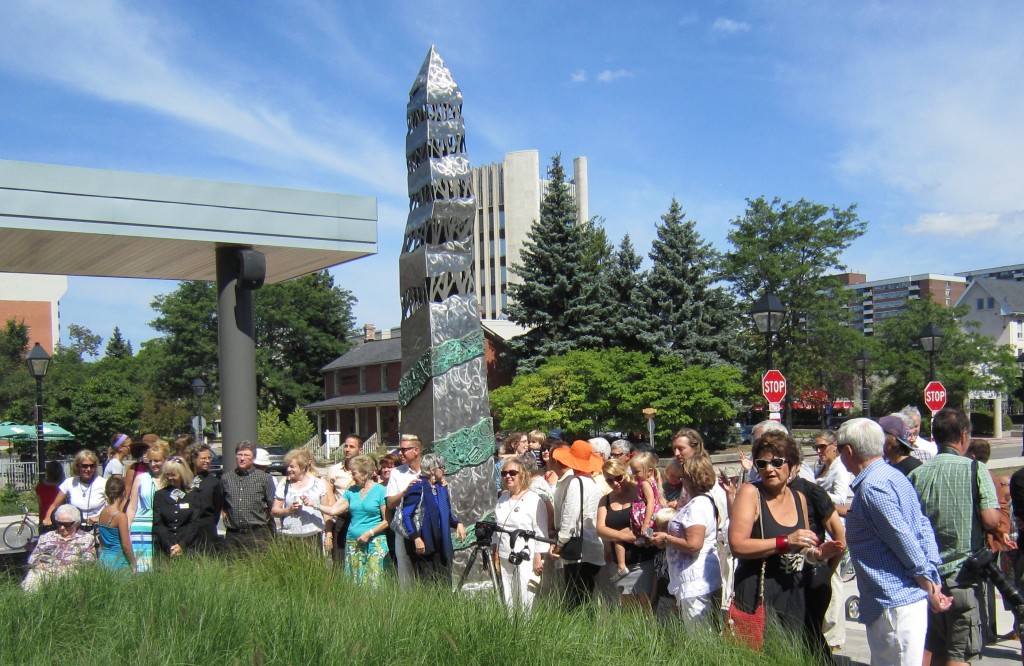 The unveiling of the Spiral Stella outside the Performing Arts Centre on a bright summer day was thought to be the beginning of a breakthrough point for the arts and cultural community. Hasn’t worked out that way, yet – but art perseveres – their day will come. Discussion on this item that was on the books for $128,000 + a one time set up cost of $8,320 started with Councillor Lancaster saying she was not on for this one – mostly because she didn’t think there was all that much to manage –and on that point she was right. The arts community saw this as a person who would do some ground breaking and seed planting.
Mayor Goldring followed Lancaster saying he would not support the expense – at least not this year. Councillor Sharman said he was where the Mayor is – not at this time.
Councillor Craven wanted to know what the impact would be without a Cultural Manager – he seemed to think that with the cultural planner in place whatever had to be done would get done.
General manager Phillips conceded that the Cultural Action Plan that Council has approved will certainly proceed much slower. She added that there is some cultural mapping being done –people are adding data on who they are and what they do to the web site.
Councillors Taylor and Dennison took a pass – made no comment.
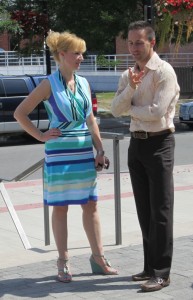 The city’s cultural planner is all the arts community has at this point. There is some cultural mapping being done – which is useful in itself but won’t do all that much to build the tremendous potential culture has in this city. Angela Papariza will use her well-developed culture background and training to work with people like Trevor Copp – not likely to see much more in 2014. For Councillor Meed Ward – it was also a “not now – re-evaluate later” an odd decision given that much of the cultural activity is in the downtown core which is her bailiwick. Meed Ward could see where this was going.
The question now is – what is the cultural planner going to do? The current occupant of the position certainly has cred within the arts and culture community but Burlington has had good people working the culture file in the past – and they have all moved on.
The hope for many was that with the surprising energy that was seen within the arts and culture community (it was always there – just not seen or appreciated) the time had come to get serious and develop the opportunity.
The Arts and Cultural Collective did as much as they could – and then some. Trevor Copp sent out a last-minute plea to the Collective membership: “Without this position, Arts & Cultural Grants, an outside Arts body, use of space and bylaw reviews in our favour is seriously jeopardized. All our work may go up in smoke. Let them know how you feel please”.
What happens next will depend on the kind of energy and leadership that comes from the general manager handling this file. Don’t get your hopes up.
Background links:
Turns out the art community didn’t get anything from the cookie jar.

 By Pepper Parr By Pepper Parr
February 20, 2014
BURLINGTON, ON
Doug Brown knows more about what Burlington hasn’t managed to do with its transit service than anyone else in the city. He has personal files that cover more than 25 years of transit history. He brings a strong personal commitment to public transit and can tell you how difficult it is to get about not only the city but the Region if you rely on public transit.
 Doug Brown and Susan Lewis look over a 1982 copy of the city’s bus schedule.  They called the bus schedule the Digest in 1982 – a time when Burlington had 18 bus routes and a schedule that fit on one large piece of paper. The current bus schedule is 28 pages long – many of the bus drivers don’t understand the thing. We met with Doug Brown and Susan Lewis to talk about the delegations each of them had made to the Community and Corporate Services Committee Brown brought along a copy of the 1982 transit schedule – which at that time was called the Burlington Digest
Last year Brown and a group known as Bfast , Burlington for Accessible Sustainable Transit, made presentations to the Standing Committee that was reviewing the budget for 2013. In their presentations, they presented what they believed was clear evidence that Burlington had continually underfunded transit. They presented the findings of consultants reports, and compared Burlington’s capital and current transit budgets against peer communities (the same communities used in the City’s budget report to compare tax rates). Bfast had hoped the City would carefully weigh the facts and either make some adjustments to the transit budget, or explain to them why they should not be influenced by the facts. To the dismay and disappointment of the Bfast people Committee members had no questions for the delegation, and adopted none of the recommendations.
Bfast hoped the committee reviewing the budget for 2014 would follow the guidelines in the recently adopted Engagement Charter and give citizens meaningful involvement in the budget process. We expect Council and staff to “walk the talk”.
Bfast was of the view that 2013 witnessed a step backwards for transit in Burlington. Despite some restoration of operating funds in the operating budget, there were many route changes which riders found confusing, resulting in reduced service on some routes. Also, the 8.4% fare increase, which was not supported by any analysis or staff report, resulted in Burlington Transit riders paying fares even higher than Toronto’s TTC. Transit users were not consulted about any of these changes. The net result is widespread dissatisfaction with Burlington Transit and a loss of riders from both actions.
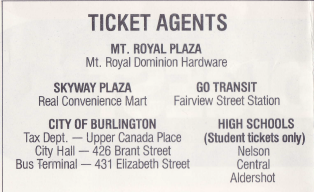 In 1982 there were a number of ticket agents throughout the city. Today there is one bus terminal which the transit people want to close; the public would have to troop over to city hall to buy a ticket. City hall closes at 4:30 pm – never opened on weekends. The 2014 budget does not increase the City’s investment in its transit system. The fulfillment of Burlington’s Official Plan and Strategic Plan require significant additional investment in transit. ROPA (Regional Official Plan Amendments) 38 requires that the transit modal share go from its current 2% to 11% by 2031. This will require an average annual increase in ridership of 10%.
The growth of transit in Burlington requires a long-term plan and funding commitment. The ongoing Transportation Master Plan is an opportunity to develop a long-term transit plan, however, we have been advised by Transportation Department staff that the Transportation Master Plan will not do this. Since the termination of the Transit Master Plan in January 2012, the City has lacked any long-term transit plan.
The budget according to Bfast, continues to treat transit in isolation to the other parts of the City’s transportation system (roads, parking, and active transportation). The majority of the capital budget is for roads, (increasing in 2014 to 54% from 51% in 2013), while transit’s small share of the capital and current budgets does not even get shown in the budget pie-charts.
During the 2013 budget deliberations Bfast we recommended the City look at traffic demand management (TDM) as a means of reducing the very costly widening of roads and intersections in the 10 year capital budget. In the case of the Appleby/Harvester EA, we have been told by the project engineer that TDM was not being looked at or considered.
There are some budget items that reflect the City’s low priority for its transit system.
We note that the funds approved in the 2013 capital budget for transit priority measures ($100,000 for 2014) have been quietly removed from the 2014 budget. Transit priority measures should be part of the Transportation Master Plan and the current Appleby/Harvester intersection plan, as such measures will reduce the car traffic and forego the need for expensive road widening.
Bus Cleaning: It is not clear what is being proposed or if more or less money is required. Bfast fears that that the City may be considering a lower standard of cleaning for the buses. This would be unfair to both drivers and passengers, and sends a wrong message to current and potential transit users. However, Bfast does support the proposal to have the cleaning done by city staff rather than by external contract provided bus cleaning is not compromised.
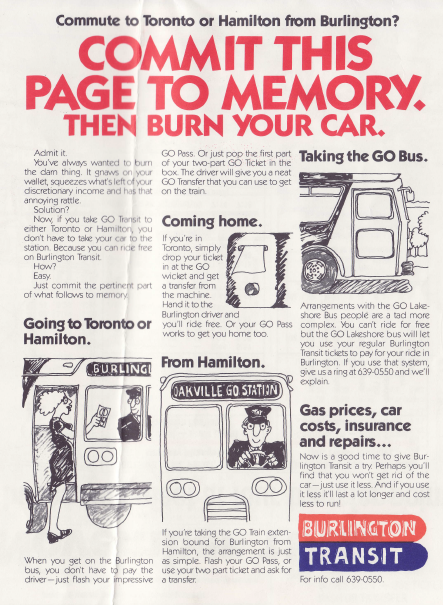 There was a time when the car did not rule and the transit department saw bus service as something that was vital. The marketing people certainly took a different approach. Imagine something like this coming out of the transit department today? Back-end loading of transit in 10-year capital budget. Bfast points out that 75% of bus purchase expenditures occur in 2018-2023 and only 25% occur in 2014-2017. Similarly, a large proportion of bus stop location upgrades and bus shelter expenditures occur in 2018-2023.
To be fair, the city has said it will be doing a total revision of the current capital budget –so anything in that budget beyond this year has to be seen as something that will be getting a very close look. Bfast might want to begin developing its own long term capital plan and prepare to take that to the city.
It appears that the City is planning to close the Downtown Terminal on John Street which Bfast describes an important place of shelter, information, tickets, and washrooms for passengers and drivers. While not a major budget item, the Downtown Terminal is very important to transit users and for the development of a walkable, liveable downtown. Ward 2 councillor Marianne Meed Ward has said she will be speaking very strongly for the retention of the John Street terminal.
Bfast argues that city council has not yet seen a detailed business case for the closing of the terminal downtown and more significantly, neither the general public nor transit users have yet seen a business case for the closing of the terminal. Bfast adds to that the Official Plan process that is holding meetings on potential mobility hubs with the downtown as one of four such mobility hubs. One of the fundamental parts of a mobility hub as defined by the City’s Official Plan process and Metrolinx is that they contain a transit terminal. Further, the Master Transportation Plans is integrating all modes of transportation including transit and at this point we do not know how that plan will deal with transit and the downtown terminal.
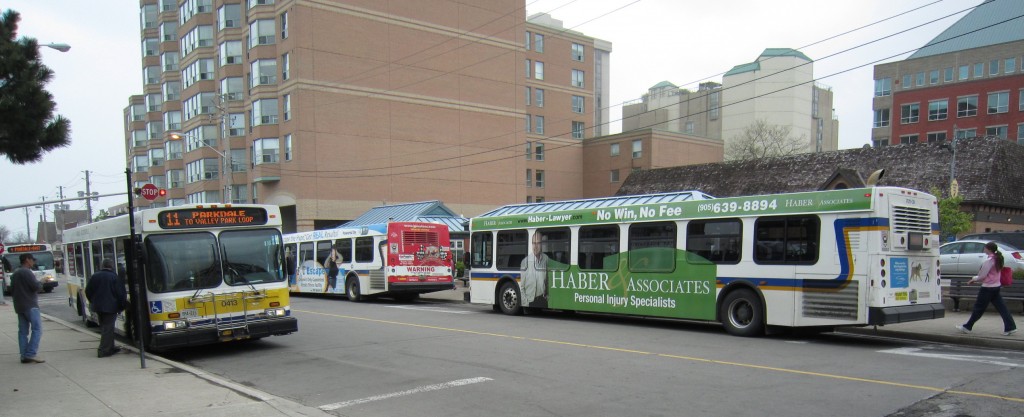 If there was ever a place to locate a transit terminal – that would be John Street where the only terminal in the city is now located. Transit department is recommending it be removed and tickets sold at city hall. Ward 2 Councillor Marianne Meed Ward isn’t buying that business case Bfast suggests this Council is not in a position to determine whether a downtown transit terminal may indeed be a necessary part of an effective transit system that can grow and serve the public effectively in the long run. Any decision to close the downtown terminal now to obtain efficiencies which translate to only $16,000 annually might create long term problems and cost the City far more if the City then has to re-introduce a terminal in the downtown. Bfast is recommending that the future of the downtown terminal be deferred until the Council is more clear on the direction of the Mobility Hub concept re the downtown and the Master Transportation Plan ideas re transit in the downtown. Further, Council needs to direct staff to consult with transit users and the public regarding a possible closing of the terminal.
In their remarks to the committee hearing budget delegations Bfast points out that the 2014 capital budget does include a major investment ($3.4M) in street-scaping in the area of the Downtown Terminal. Surely, this is an opportunity to redevelop the present “kiosk” into a first-rate terminal facility.
There are parts of the transit portion of the budget that confuse Doug Brown, part of the Bfast committee. Referring to a part of the budget about Restoring Transit Services, Brown says “it is unclear exactly what is meant by the item, we haven’t seen the separate report referred to in the Budget document. It would be logical to assume that the Restore Transit Services item comes from the lost capital revenue from changing the federal gas tax funding from a 70-30 split to 80-20. ($500,000 for two years gives $1,000,000). This shouldn’t be regarded as an additional funding option since the funding is already there, just diverted to roads.
Bfast believes Burlington Transit needs to put money into new, (replacement and additional), buses, more shelters, real-time schedule information online and at bus stops, and, more marketing.
When Burlington created its first really relevant Strategic Plan it had no idea how readily the citizens would take to the document. There are very few delegations made that don’t refer to the document. Bfast puts a firm grip on the making Burlington “a walkable, liveable community”. Brown points out that this view has been reinforced by some thoughtful presentations at the bat the Mayor’s Inspire Series where Christopher Hume and Gil Penalosa spoke. Brown wants to see at least some of the ideas that were brought to the city adopted. If we aren’t going to pay any attention to the experts we bring to Burlington to talk to us – then why bother bringing them?, asks Brown.
Dan Burden, an urban planning expert, was engaged by the City to “set the tone” for the Transportation Master Plan. Burden recommended the City create narrower streets to create street life and make the streets safer and more useable by pedestrians and cyclists.
However, the 2014 Budget includes very large expenditures for widening the roads and intersections ($21M for Walkers Line & North Service road and $23M 10 yr. total for Harvester – Appleby to Guelph Line) while, transit, sidewalks, and safe cycling facilities have been underfunded.
 Doug Brown, chair of Bfast, wants to see a bus schedule with routes that work for people and not the current bus route set up in place. It doesn’t work claims Brown. Susan Lewis, who does not drive looks on. There are places she just cannot get to in the city because transit doesn’t work – at least not for her. Brown makes a point that many make on the budget review process Burlington has in place. “Public input on the Budget has again come at the 11th hour, when large changes to the budget are not possible. We encourage the City to provide their citizens with a much earlier opportunity to help shape the budget in the future.”
Doug Brown is chair of Bfast. He brings degrees in science and engineering to the volunteer work he does. What boggles a lot of people is that Brown isn`t used by the city as a significant source of information and advice. Doug Brown was riding the bus in Burlington before the current Direct of Transit Mike Spicer even got to this city.
The city has an asset it needs to consider leveraging.
There is a lot more to be written about transit and how people like Susan Lewis get around in the city. Let’s see what city council decides to do with the current transit budget.

 By Pepper Parr By Pepper Parr
February 19, 2014
BURLINGTON, ON.
You can`t fault Councillor Jack Dennison for trying – and try he does. During a Standing Committee last week when discussions on the capital projects the city will take on in 2014 as they spend the $67 million plus that council is expected to approve Tuesday evening, Dennison felt there were opportunities that were being missed and wanted the city to consider selling the Tyandaga Golf course property.
 Ward 4 Councillor Jack Dennison always has an eye open for an economic opportunity – sees a great one for the city: sell the golf course. “This isn’t a business we should be in” Dennison commented, echoing remarks city manager Jeff Fielding had made more than a year ago. While Tyandaga is currently running at a bit of a profit that was not the case a couple of years ago. At that time the golf course juggled its business model and tightened up its management practices and the profit and loss statement began to look better.
Dennison just doesn`t think the city should be in the golf course business and pointed to the “40 golf courses” in the surrounding communities – that number might be a stretch, but Burlington certainly has its share of golf clubs that are a 15 minute drive from the downtown core. Should the city be in a losing business when there are plenty of very good private golf clubs in the community?
 Ward 4 Councillor Jack Dennison sees 200 homes on the Tyandaga golf course property and thinks the Catholic Diocese property that front on Brant Street could be made a part of the project as well. Dennison saw the 110 acre Tyandaga property as prime residential development land and talked of being able to get something between $12 and $18 million for the land alone. He added to that the immense development charges that would accrue to the city and then the tax assessment which he pegged at $200 million.
Dennison told his colleagues that the property had 33 acres of land that could be developed and because of the location he saw at least six houses on each acre getting pretty close to 200 homes on a prime site that would have 76 acres of parkland.
Before we knew it Dennison had $1.6 million in additional tax revenue in the city’s coffers.
 The golf course wants to spend $150,000 this year on upgrading parts of the golf course – Dennison wanted to defer that spending while the city took a closer look at the property and the opportunity he felt it offered. The golf course wants to spend $150,000 this year on upgrading parts of the golf course – Dennison wanted to defer that spending while the city took a closer look at the property and the opportunity he felt it offered.
The rest of Council wasn’t as gung-ho as Dennison. They Mayor said it looked like a “cash grab” to him but didn’t explain what was wrong with wringing cash out of an underperforming asset.
The rest of Council didn’t get very excited either. Ward 1 Councillor Rick Craven was delayed in getting to the Standing Committee meeting and missed a discussion that would have taken a major public recreational service off his plate.
Councillor Sharman took the high road and said the selling of the golf course had to be looked at in a “broader context” but didn’t elaborate on what that meant other than to say that the city was “not ready for the discussion”.
Councillor Meed Ward piped in with her view that adding residential assessment isn’t always a good deal for the city. “For every dollar of tax revenue we pull from residential properties we end up, over time, spending a $1.40 Dennison came back with “that argument doesn’t really hold all that well”.
Council needed some input on just what the planned spending on the golf course was for and called Director of Parks and Recreation Chris Glenn to the podium. Odd as it may sound Glenn wasn’t able to say just how many golf courses there were in Burlington, nor could a member of his staff come up with a solid number.
 Were anyone to ask a privately operated golf course what their competition was you would expect them to tell you exactly how many competitors they had and be able to tell you which were their closest competitors in terms of course usage and revenue. The mindset of the private sector is a lot different from the mindset of the public sector where the renewal of an asset is based on a chart or a schedule that dictates when an asset has to be renewed. The private sector operator would wring every possible nickel out of a piece of equipment. Any expenditure comes out of the bottom line which tends to be the owners pockets. Were anyone to ask a privately operated golf course what their competition was you would expect them to tell you exactly how many competitors they had and be able to tell you which were their closest competitors in terms of course usage and revenue. The mindset of the private sector is a lot different from the mindset of the public sector where the renewal of an asset is based on a chart or a schedule that dictates when an asset has to be renewed. The private sector operator would wring every possible nickel out of a piece of equipment. Any expenditure comes out of the bottom line which tends to be the owners pockets.
Glenn explained what the $150,000 was going to be used for – and added that it wasn’t really a capital expenditure from the city’s point of view – the expenditures were going to come out of reserves the golf course had in place.
For Dennison it was an opportunity that was being missed; he wanted to see the asset being used in a much different way. He didn’t manage to convince his colleagues to go along with him – the motion to defer the item was lost on a 4-2 vote. But Dennison did manage to plant a seed – the city manager is way ahead of him on this one. When city council decides what businesses it wants to be in – the golf course business is not likely to be one of them.
Another question is: will Jack Dennison be on Council to see this kind of development take place.
At the Tuesday evening Council meeting the Capital budget was approved for 2014. There are loads of items in the longer term capital budget that will be getting a much different look during the year. City hall will begin the process of totally recasting capital expenditures as it reorients itself to its new financial reality. Among the projects in that capital budget that will be getting a closer look are the railway underpasses on Mainway and Burloak – neither is going anywhere in 2014 – both will be getting a closer look as the longer term capital budget gets its remake.
On the books for the 2015 to 2023 capital spending is a massive $494,012,195 in capital spending. City manager Jeff Fielding looked at the cookie jar and knew pretty quickly that the number wasn’t possible – thus the decision to totally recast what we want to do, what we have to do and what we can do in the way of capital spending for the next 15 years.
 Lori Jivan, on the right, Acting coordinator budget and policy with the city explains the 2014 budget at a public meeting. With the capital budget of $67,973,902 nailed down – let’s look at where the money is going to come from: Lori Jivan, Acting coordinator budget and policy explains:
External other: These are monies the city gets from other place, could be the provincial government, the Region or some other municipality we are doing a joint project with. If Tremaine Road was having work done on it – because it is our border with Oakville they might be paying part of the cost. We pick up $10,089,000 from this source.
Debt: We sometimes decide to borrow money to pay for a capital project. This year the city projects they will borrow $6,903,000
Cash from the current budget: This is tax revenue – money the city collects as taxes. A portion of the tax money gets pushed into the Capital account. For 2014 they are moving $16,684,000 into capital expenditures
IRRF – this is the Infrastructure Recover Fund which amount to $2.000.000 the city gets from Burlington Hydro. It comes to the city from Hydro as a dividend which the city places in the Infrastructure Recovery account. $2,000,000
SCD: Special Circumstances Debt. This is an estimate of the amount of debt the city will have to take on for special project – one time situations that might get taken on. The Performing Arts Centre is an example of a one time Special debt.
FGT: Federal Gas Tax. The portion of the federal gas tax that the city receives. For 2014 that is set at $4.774,000
Provincial Gas Tax PGT: The portion of the provincial gas tax the city receives. For 2014 that is set as $850,000.
Reserve funds will be used with $20,648,000 coming from the development charge reserve and $5,027,00 coming from what the city calls “other”.

 By Pepper Parr By Pepper Parr
February 11, 2014
BURLINGTON, ON.
City manager Jeff Fielding has to be a happy camper today. Council gave him $67 million and change for the various capital projects he has on the go. Actually he got $67,973,902.
Council like to go through these budgets and lop off a bit here and a bit there to leave the clear impression that have a grip on the spending. Part of the budget process is to have council members send in the items they want more information on – there were 25 pages of those. If a Council member wants then to debate the item they put it on a list.
 This year there were 17 items from just two council members: Dennison and Taylor of ward 3 – both whom have been on council individually for more than 20years This year there were 17 items from just two council members: Dennison and Taylor of ward 3 – both whom have been on council individually for more than 20years
 Ward 4 Councillor Jack Dennison, who knows the Tyandaga part of the city very well – used to represent that part of the city – wants to see a couple of hundred million dollars home on the land. His thinking appears to be aligned with that of the city manager. Capital projects are all those roads, buildings and vehicles the city needs to keep things moving. At one point it looked as if Fielding was going to have an additional $10 million in savings when Jack Dennison, ward 4 came up with an idea that would have the city out of the golf business and sell of the Tyandaga property and get a couple of hundred high-end single family dwellings built. Dennison had figured out everything except the potential development charges but his colleagues weren’t buying it – too premature they said.
However, the writing was on the wall for Tyandaga – too many people see it as land that can be put to better use. Dennison said there were 40 golf clubs in the area – that number seemed high – Parks and Recreation Director Chris Glenn wasn’t able to say how many golf clubs there were in the city, which seemed odd.
Sometime last year city manager fielding did say that he had some ideas about the Tyandaga property – felt there was more value for the place than the city is getting from operating a golf course.
There was a $250,000 capital expenditure related to what city hall – staff and elected council members want to do with city hall – but the lips got kind of tight when that subject came up. Dennison wondered of part of that quarter of a million couldn’t be moved back to 2015 but Allan Magi, Executive Director of Corporate Strategic Initiatives explained that there was a report that would get produced and presented in June that would set some of the “high priorities” and “options” for the city.
Because this is a real estate matter fielding didn’t want much said by anyone to anyone. He told Council he would get back to them with a confidential memo that would tell all – but it wouldn’t be telling all to everyone.
Get ready for some interesting ideas on a significant city hall initiative – maybe a new one. Bet on it staying in the downtown core.
There will some of that stuff that is known to hit fans in the late Spring or early summer – which is when Council members will be gearing up their re-election campaigns. One of the ways to deflect the details on the pier and its legal fallout would be to get all warm and fuzzy about a brand new city hall that is going to (finally) revitalize the downtown core.
 Marianne Meed Ward chaired the meeting – she runs a swift, no-nonsense meeting; this is a council member that has learned a lot in the four years she has served the city. Much more focused when it comes to running a meeting. As chair she gets to talk as long as she wants – and to the delight of her colleagues she has learned that 50 words can often do as much as 500 words. Marianne Meed Ward chaired the meeting – she runs a swift, no-nonsense meeting; this is a council member that has learned a lot in the four years she has served the city. Much more focused when it comes to running a meeting. As chair she gets to talk as long as she wants – and to the delight of her colleagues she has learned that 50 words can often do as much as 500 words.

 By Pepper Parr By Pepper Parr
February 10, 2014
BURLINGTON, ON.
With the city budget determined as both capital costs and Operating costs – it can still be very confusing.
Council members have tons of questions. Rather than have some questions asked several times city staff pull
together all the questions and consolidate them – letting staff dig out the answers and put the collection in front of council
– it runs to 25 pages.
 Markings identifying portions of the street intended for cyclists. Future plans for bike lanes:
Setting aside part of roadways for cyclists is still a work in progress in Burlington. The cycling advocates
lost the battle to have dedicated lanes on Lakeshore Road – something to be remembered come the
civic election.
Question: Provide a consolidated breakdown of capital funding sources and total cost to install bike lanes for the projects identified in the capital budget.
Response: Preliminary Bike Lane forecasted costs
Ref # 2 Appleby Line @ Harvester Intersection
$ Costs if part of road expansion
Standalone costs (no planned expansion)
Year 2018 $22,000 $822,000
Ref #
|
5
|
Harvester Road @ Guelph Line IntersectionYear 2017 |
$22,000 |
$148,000 |
| Ref # |
6
|
Harvester Road – South Service Road to CenturyYear 2017 |
Drive$161,700 |
$823,200 |
| Ref # |
7
|
Harvester Road – South Service Road to WalkersYear 2017/2020 |
Line$365,200 |
$699,500 |
| Ref # |
8
|
Lakeshore Road – Maple Avenue to City LimitYear 2015/2017 |
$451,000 |
$957,000 |
| Ref # |
11 |
North Service Road @ WalkersYear 2014 |
$187,000 |
$277,000 |
| Ref # |
12 |
Waterdown Road NorthYear 2016 |
$528,000 |
$818,000 |
| Ref # |
13 |
Waterdown Road WideningYear 2014 |
$72,600 |
$312,600 |
| Ref # |
16 |
Plains Road Reconstruction |
|
|
| Year |
2015 |
380 m @ $220 /m = |
$83,600 |
$1,005,000 |
| Ref # |
17 |
South Service RoadYear 2016/2017 |
$52,800 |
$209,600 * |
| Ref # |
19 |
Brant Street @ Plains RoadYear 2017 |
$22,000 |
$66,000 |
| Ref # |
20 |
Harvester Road @ WalkersYear 2016 |
$22,000 |
$272,000 |
| Ref # |
21 |
King Road – SSR to NSR |
|
|
|
|
Year 2019 |
$57,200 |
$2,532,000 * |
| Ref # |
23 |
Walkers @ DundasYear 2016 |
$22,000 |
$52,000 |
| Ref # |
24 |
Walkers @ Upper MiddleYear 2018 |
$22,000 |
$122,000 |
| Ref # |
25 |
Waterdown Road Bridge Widening at Hwy 403 |
$17,600 |
$1,500,000 * |
| Ref # |
28 |
Burloak Drive Grade SeparationYear 2020/2021 |
$44,000 |
$2,000,000 * |
| Ref # |
31 |
Lakeshore Road ReconstructionYear 2019 |
$37,400 |
$179,100 |
| Ref # |
32 |
Plains Road @ York Blvd RoundaboutYear 2023 |
$33,000 |
$83,000 |
| Ref # |
33 |
Walkers Line – Hwy 407 to No 1 SideroadYear 2020 |
$239,800 |
$824,800 |
| Ref # |
85 |
Eastport Drive Cycling ImprovementsYear 2017 |
$11,000 |
$1,000,000 * |
|
|
TOTAL
|
$2,473,900 |
$14,702,800 |
Harvester Road corridor:
Question: Harvester Road Corridor Improvements and Widening. Provide the total cost of all works proposed along the Harvester Road corridor.
Response: The total gross cost of projects along the Harvester Road corridor is $ 27,489,500.
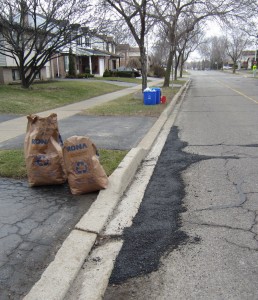 Sealing cracks on roads is one of the preventive maintenance tools before a road has to be rebuilt. Shave and pave have proven to be money well spent – and we are spending a lot of money on this tool. Road repairs – sealing cracks:
Question: Provide the list of suggested roads that will be crack sealed.
Response: The following table identifies the proposed 2014 crack sealing candidates
| Road |
From |
To |
| WILLOWBROOK RD |
PLAINS RD |
ENFIELD RD |
| GLENWOOD AVE |
NORTH SHORE BLVD |
TOWNSEND AVE |
| RICHMOND RD |
MAPLE AVE |
HAGER AVE |
| POMONA AVE |
LAKESHORE RD |
SPRUCE AVE |
| PINE COVE RD |
SPRUCE AVE |
NEW ST |
| ROCKWOOD DR |
WOODVIEW RD |
WALKER’S LINE |
| TURNER DR |
LONGMOOR DR |
BENNETT RD |
| GRAPEHILL AVE |
WALKER’S LINE |
STRATHCONA DR |
| MELBA LANE |
SPRUCE AVE |
STRATHCONA DR |
| LINDEN AVE |
HAWTHORNE AVE |
SPRUCE AVE |
| REEVES RD |
WHITE PINES DR |
TOTTENHAM RD |
| MAPLE |
LAKESHORE |
FAIRVIEW |
Downtown street lights:
Question: Is the sum of $884,000 in addition to the $1.9 million included in previous budgets to complete Decorative Street Light Restoration works on the downtown?
Response: The sum of $884,000 is new funding. The restoration project is to start in 2016 and continue yearly for 4 years with an expenditure of $222,000 per year. The previous Capital funding was for the reconstruction of Brant Street, burying utilities and installing Decorative Street Lights.
Central Arena Facility Renewal/Enhancements – Skyway
Question: Is money needed for these arenas? What is the future direction of Skyway?
Response: Funds for Central Arena are identified for 2015 and funds for Skyway Arena are identified for 2017. Staff will be conducting an ice needs review in 2014 to determine if the current inventory will meet customer needs for the next 5-10 years. The results of this review will be presented to Council. If the review warrants major renovations to either arena, staff will submit a business case in conjunction with the 2015 budget submission.
The capital budget will be recast in 2015. As such, the 2014 capital budget and forecast focused on 2014 projects. The project in the capital budget assumes a revitalization of Skyway Arena based on life cycle renewal requirements. However, prior to proceeding with this a strategic review of the need for this facility vis-a-vis ice user needs as well as other community needs will be under taken as directed by Council.
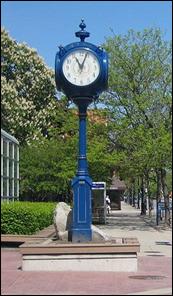 Longer term thinking has city hall being replaced but for the immediate future improving the sound system in Council chamber – FINALLY! and improving some of the meetings rooms is where capital dollars will be spent this year. City Hall:
Question: What work is being done on the city hall building for the $250k in 2014?
Response: A City Hall Administrative Study is underway which will provide a recommended strategic option for City Hall needs. Funding identified in 2014 is to advance the high level option recommended in this study to design development including costing for capital budget purposes.
Looking at what to do with city hall long term doesn’t mean it will be left to disintegrate.
Question: Provide the detail of the work being done in 2014 for public meeting rooms and council chambers.
Response: (a) Meeting rooms on 3rd floor: Replacement of carpeting, furniture and technology. (b) Council Chambers: Audio equipment only.
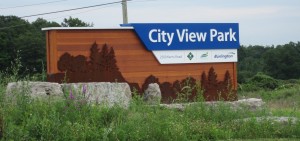 Now the biggest park the city has – and the furthest from the bulk of the population. City View Park:
It is now the biggest park the city has – but very few people get to use the place tucked away as it is in the north-west sector of the city – easier for Waterdown people to get to the place.
Once you are there – the site is wonderful. Many don’t like the plastic grass and argue that we will rue the day we have to pay for its replacement and cost of getting rid of it. It was hoped the location would be a big Pan Am Games attraction but all Burlington is going to get is a decent chunk of rent money for space soccer teams use to practice. The public will not be allowed onto the site during those practices.
Question: Outline the need for the 1.8 FTEs and $158K of operating requirements in 2016 and 2017.
Response: 2014 request of $5K supports the portable washroom facility required at the site. The amounts for 2016 and 2017 should be adjusted as follows:
Move request for $15K and 0.3FTE from 2016 to 2015 to provide a student for maintenance of the 3 premier sports fields starting in the Pan Am year. This student will work weekends and will provide a presence in the park, collect litter, groom fields as needed, inspect the trails and ensure the fields are being used as permitted. Three artificial turf fields have been built out and the large investment in this infrastructure requires a greater level of oversight and service.
Move request for $143K and 1.5FTE to 2019 when the Pavilion construction is scheduled. The FTE’s are for one permanent staff person (Equipment Operator) and one seasonal temp. With the build out of the pavilion, the washroom building will be open and the picnic areas. Much like other city parks (such as Central, Nelson, Sherwood Forest, Millcroft, Lowville) the investment in infrastructure combined with high use require increased staff levels to ensure that maintenance standards are met.
 Information technology is everywhere – but not always something you can put your finger on. Done well it will save most people time and the city administration a tonne of money. Expensive – yes – but we couldn’t exist without it. Information technology:
City hall is going to use the internet as much as it can to both improve its communication with its citizens and to reduce its costs. The Information technology department will be charged with delivering on the policy that Council decides upon.
There will be some bumps along this road – we don’t have an IT department that manages to be ahead of the curve in the IT field – to be fair few municipalities are able to keep up with the change. Major corporations stumble on this one. Add to that – that technology takes longer to complete – almost every time.
Project: E-Government Strategy Implementation
Question: a) How much funding has been committed to the E-gov’t program (to date and future)?
b) How many FTEs (permanent and temporary) are assigned by year?
c) With the money being spent, what will be the outcomes / transactions?
Response: a) The E-government program funding is:
Approved to-date:
$1.21 million (2011 – 2013 capital budget requests for software, hardware, implementation, IT staff costs). The projects supported with this funding are the web portal, e-commerce, public involvement, community calendar, service requests.
$490,000 (current budgets for business project staffing costs). These staff are supporting projects for recreation services, web design and migration and overall e-government program implementation. (one-time expense)
2014 capital request:
$240,000 to support projects in development services, open data and staff support.
Total of $1,940,000. This reflects what was requested in the 2012 budget in a 3 year capital program (2012 – 2014).
b) Staff assignments to E-Government Program:
Program manager 3 years, Business Analyst – 2 years, Application Analyst
– 2.5 years, P&R Business Lead – 1 year, Web Specialist – 1 year. The Program Manager and Application Analyst positions finish in 2015 and all others end in 2014.
All of the positions are temporary assignments done through secondment or contract.
c) E-Government Program deliverables are focused on enhancing and expanding our customers’ online experience. Our goal is to introduce more electronic service options for the public and enhance the information access/search ability with improved navigation.
Services delivered to date include: The online Live and Play guide with direct connection to program registration, Public engagement through MindMixer, Tax bill/statement electronic distribution and payment through EPost, Online Tyandaga tee time bookings, P&R program waitlist notification and receipt printing, Online facility availability, Online P&R membership registration.
City information data sets available through our Open Data project for developers and interested community members e.g. our transit schedule is now available through free apps to make it easier to know what bus to take based upon where you want to go.
Our future deliverables are:
Providing a single online reference point for Public Involvement opportunities with the City through a new web page
Online facility availability to meeting rooms and picnic spaces
Revitalized map views to make them easier to use and understand
More data sets for developers to create apps for our citizens to use e.g. cycling routes, construction plans, approved budgets
A new website with the ability to put more services and information online in an easier to access format e.g. service requests, development service permits and applications
An enhanced community calendar
A more user friendly and flexible e-payments solution
Emerald Ash Borer
This is one of those projects where we often don’t know that we are doing – but then no one else in the field knows all that much either. It is complex, based on science that we are still learning about and it is expensive. The hope is – and that’s basically all we have at this point – is that we can keep ahead of it. Not much of an upside but the downside is to lose thousands of trees – and if tax payers are concerned about property values – imagine a street that loses all of its ash trees. This is a tough one.
 This little creature is costing us a fortune – and we are not at all certain we are going to win the battle to stop the infestation. Question: a) How effective is the current program?
b) What were the results of the pilot program in Oakville?
Response: a) Although the effectiveness of the current program is still being understood, observations indicate that treatment has contributed to the prolonged life of ash trees. To date, the trees requiring removal have been primarily those that are untreated and there has not been a significant impact to treated trees. In some cases, non-treated trees have been removed beside treated trees that are still standing.
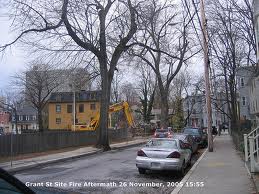 How much damage can the Emerald ash bore do? Trees in Cambridge that are lost. b) Staff will request information from Oakville staff about the results of their pilot study and provide Council with this information as it is received.
The above are a few of the items in the capital budget for 2014. The numbers are for the most part place holders while the city totally re-casts the capital budget for 2015 – which is when the new budgeting tools begin to come into play. Service based budgeting, Result based accountability and new Business process management tools will become THE approach used at city hall.
Will they make a difference. You want to hope so – there are some costs coming our way that could cripple the 2020 taxpayers.

 By Pepper Parr By Pepper Parr
February 4, 2014
BURLINGTON, ON.
Where would you go if you wanted to figure out what RBA and BPM and SBB meant? You could do worse than talking to someone who has CIA, CCSA, CFE, CGAP, CRMA behind her name, which is what Sheila Jones, the city’s auditor has behind her name.
And she can explain what RBA, BPM and SBB mean and why they are both very relevant and important to the financial management of the city.
Burlington has, up until the 2014 budget year, based its spending on what each department does. City manager Jeff Fielding has changed that approach to a focus on the service that is delivered to the citizens of the city.
The objective is to first identify the services the city is in and decide if these are businesses we want to be in. There are a total of 54 services, of those 13 are internal to city hall – think legal and HR; leaving 41 services delivered to the public. Of that 41 – 31 are delivered by the city. Others are delivered by other levels of government. Region is an example – they handle water and waste removal.
If the residents of the city, and let us hope that it is the residents who make the decision along with their council members, and not just the administrators at city hall, decide a particular service is something they want and are prepared to pay for the city manager will assign responsibility and accountability for the effective and efficient delivery of that service to a specific person.
As a broad approach to the delivery of services it would appear sensible – now how do you define the metrics that will be used to measure the value of the services and determine if it is being delivered in an effective and efficient manner?.
 Sheila Jones, CIA, CCSA, CFE, CGAP, CRMA, Burlington’s first auditor Back in December, at a Committee of the Whole meeting Auditor Jones took Council through a detailed overview that left them with more questions than answers. Jones used about 45 minutes to lay out the changes that were in the works and asked for feedback.
She started by explaining what was going to be fundamentally different.
 The city is moving from a traditional approach to budgeting where all the expenses were attached to a department. They are moving to an approach where the expenses are attached to a service the city delivers. The city administration does see this as an effective way to manage the city. The approach is going to be for staff to provide Business Plans and Cases, Performance Tracking and Monitoring, Performance Reporting and Continuous Improvements.
At the end of this process the city manager expects to be able to ask, and answer two critical questions. There is a third question that you the voter will get to ask and answer.
Fielding is requiring his staff to tell him:
How much did we do?
How well did we do it?
He then wants you, the public, to tell him if you are any better off?
The process he is putting in place certainly has merit. Fielding is the kind of guy who thinks things through but isn’t afraid to change his mind if he didn’t get it right the first time. He has a lot of experience with “unintended consequences”.
The time line for all this:
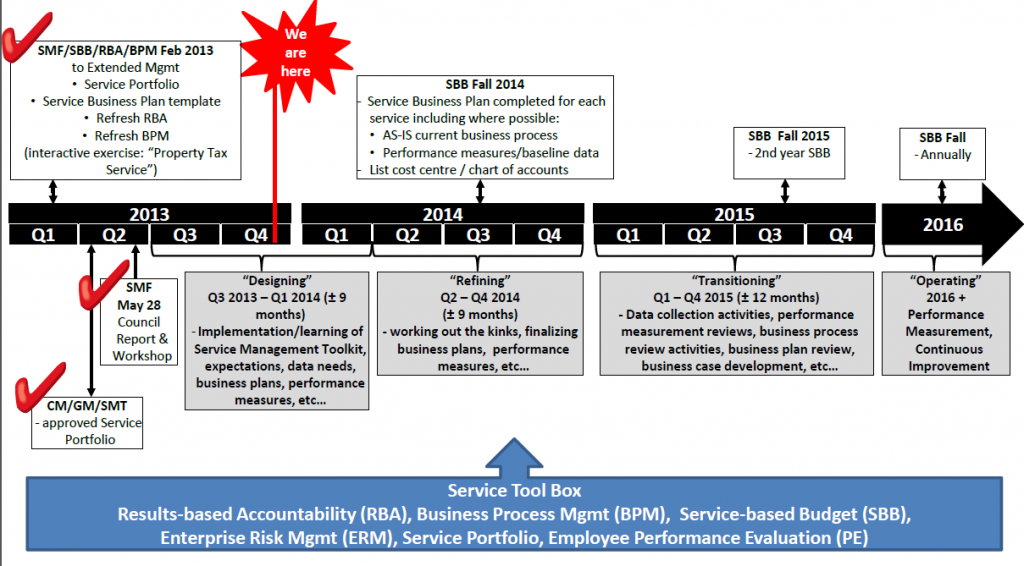 First, if you ever wondered what they do at city hall – charts like this are an example. This was not an easy task. It sets out the time frame to get to the new approach. This will be a very significant shift for staff and will be the making of careers for some and maybe early retirement for those who can’t make the transformation. Public input and education are a critical part of this process. What the city wants to do is promote dialogue about: Service management, Council and Service Owner roles and responsibilities, and the portfolio of services delivered to the public.
The city wants input on the level of service performance accountability reporting people want to see, along with the Importance and value of services delivered.
Auditor Jones wanted to know where Council felt they fit into the process. Were they OK with maintaining a strategic view of services by making decisions regarding commissioning and/or decommissioning of services; increasing and/or decreasing service levels and their appetite and/or tolerance for risk and a review of service portfolio?
Examples of de-commissioning a service can be seen in the 2014 budget. Do you want leaf collection in the fall as frequently; how often do you want sidewalks plowed.
Jones asked: Do you accept Council’s role and responsibilities? 100% they said BUT, …there was still some work to be done to show the link from strategic goals to performance management.
The report that was being discussed set out Senior Management, Service Owner and Staff Role and Responsibilities. Each was to:
Maintain an operational and tactical view of services by: making decisions regarding how services are delivered within the limits of Council approved service levels and budgets; determining, tracking/monitoring and reporting on performance and identifying risks; determining and implementing opportunities for continuous improvement; reviewing services and maintaining the service portfolio based on the decisions of Council.
Jones went on to give a detailed example as to how this would work using Burlington Transit as an example. Those details will be part of a different article.
Everything the city does under the 2015 budget will be somewhere within the Service Portfolio that is currently being revised and refined. That data is expected sometime in the spring when it can ideally become part of the election debate.
At this point in time the service portfolio consists of:
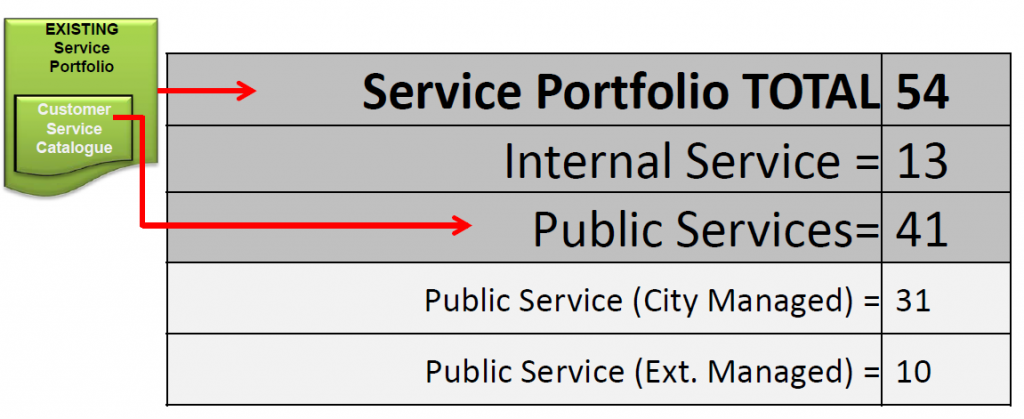 A Service Portfolio is a list of all the services the city delivers. With the new Service Based Budget there will be a business plan for each service that will be approved by each Council at the beginning of its term of office. This basically sets out what the city is going to deliver.
Full details of that portfolio have yet to be released – there could be some surprises in that document. The core, the foundation of this new approach is the service that the city delivers. What services does the city want to be in and which services does the city want to get out of. This is a Council decision – what staff want to know is: What is the most suitable cycle time for a Council to review the service portfolio? 60% said at the beginning of new council term; 60% said some other time and 20% said at the beginning of each year. That comes to 140% – is this a harbinger of the kind of number stuff we can expect?
Every service will have a Business Plan that sets out the rational, purpose and the expectation the service will deliver. Whenever there is a change to the Business Plan a Business Case has to be provided.
One assumes these business plans and business cases will be on-line, which, if the Strategic Plan is any example, the public will pick up on very quickly and begin to demand that what is published is delivered. Which is exactly what city manager Jeff Fielding wants them to do – he wants the public to hold his staff accountable for his staff to learn to be accountable to the public they serve.
What is going to be in a business plan: Service Banner, Current State, Sub-services, Recent Continuous Improvements Initiatives, Financial Investment, Human Resource Investment, Emerging Opportunities & Anticipated Risks, Measuring Success and Service Objectives.
The presentation was extensive. Each of the parts of the Business Plan had forms that staff had to complete.
It all starts with what city people call the Service banner which a high level view of what the service is, why it is being delivered, what it will cost and how it will be reviewed by city council.
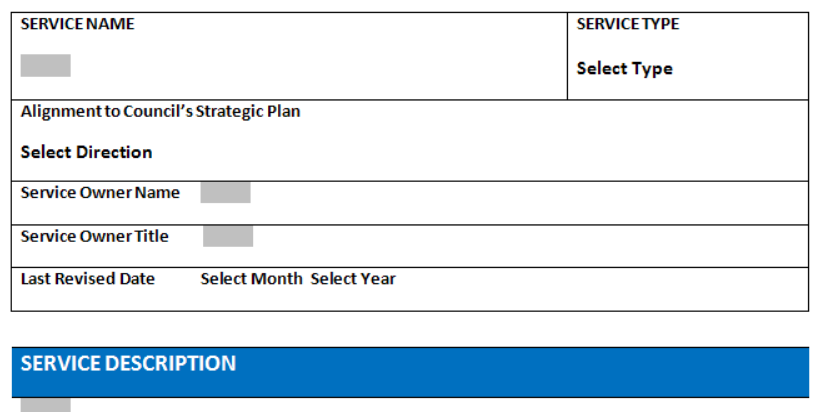 The document that sets out the high level view of the service being delivered.  This type of document sets out the working plan for a service. The focus is always on improving the quality of the service and keeping the cost in line. 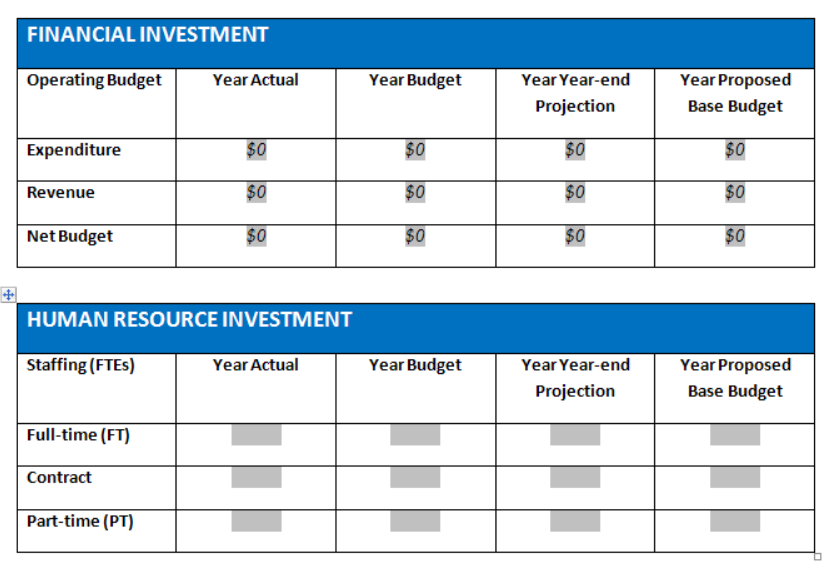 How much money has to be put into the service and what are the HR needs. Burlington has managed to keep the number of people on staff down – and without the use of all that much in the way of contract work.  City manager Fielding wants to see improvements and realizes that means taking some risks – and some of those risks will not work out. Staff can advise Council, Council has to make the decision. The public has to learn that changes need to be made and that much of the territory we are moving into is uncharted waters. Mistakes will be made and the public is going to have to learn to accept the mistakes. The Pier was not a mistake – but it was a classic example of terrible oversight and shockingly poor management.
 These are the documents that performance evaluations are going to be based on: Did city hall deliver – and if they didn’t, why not and if the why not isn’t satisfactory maybe HR will suggest another line of work – outside city hall. 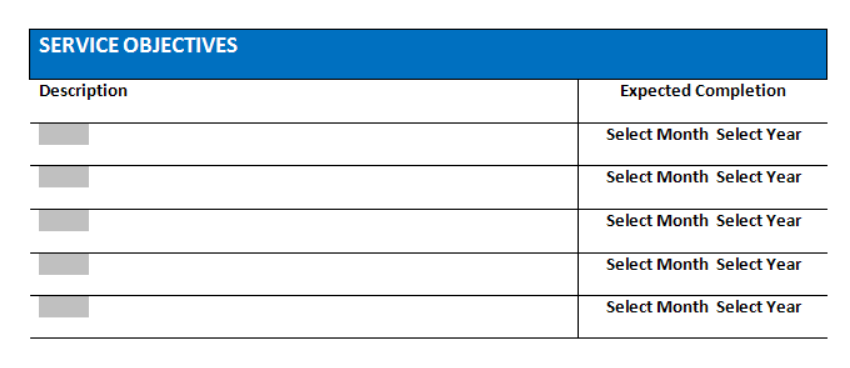 For city manager Jeff Fielding it is all about improvement in the way services are delivered along with a hard look at what the city wants to actually deliver. Fielding isn’t a hard-nosed, cut everything to the bare bones. He thinks the flowers along main roads is a plus and are a part of what makes Burlington the top city it is – BUT he wants to make sure the public fully understands the costs – and is prepared to pay them. Fielding says the ear he has to the ground tells him the public is prepared to pay the cost for the extras – Council of course has to make that decision. With Council having had an overview of the process Auditor Jones wanted to know how they, Council, wanted to track what was being done.
She proposed that Council review the service portfolio at the beginning of each new council term. The Service Portfolio is that list of all the things the city does – the different businesses they are in.
All the Business Plans for all the services in place would be before Council and be made part of the orientation process for a new council and reviewed again annually during the budget process.
Council would look only at those services that have had a change made to them which would be shown in business cases that would be before Council. Waiting for a staff member to decide a change was needed and that a business case should be written up works only if you have a civil service that is responsive and genuinely feels they are accountable to the public. Many are, quite a few are not – it’s a culture change that is still being created.
Auditor Jones then wanted to know: What is the appropriate frequency of reporting performance
Measures; 40% said quarterly; 40% said semi-annually and 20% said annually
Jones took the middle road and proposed that management report to Council semi-annually to coordinate with financial reporting starting in 2015.
Management proposed to assess quarterly as the methods and data for calculating performance measures become stable, predictable and easy to access. This is a work in process that will need quite a bit of fine tuning.
Jones then poses the critical question: What does the public needs to know? Key messaging would include: what is the service portfolio?; why is it important to them? why should they care?; what is the service management framework?; what is a business plan?; what is service based budgeting?
The intention is to do this work in Q2 2014 using various communications channels along with Council involvement to actively engage the public in a process of education and awareness promotion.
Jones is close to emphatic when she says the city needs this valuable information from the public to assist Council in making decisions about services and service levels and to help administrate and prioritize initiative and activities. The city will begin gathering this kind of information in Q3 of 2014 for the 2015 budget and every year after that to inform the budget process.
What is the most suitable cycle for review of a service?
When a service review is defined as a formal undertaking by the service owner to ensure what is delivered is of the highest value to the community; that it applies best modern practices for cost-effective delivery, and directs valuable, limited resources to the delivery of community valued programs and services, a business case is prepared. The limitation here is that it is the service owner making the decision to review. The city might want to look for a way to pull the public into the process.
Council split on that approach as well: 40% said let’s do it bi-annually; 40% by priority sequence and 20% based on some other criteria.
Management came back with having management determine a service owner and Council requirements and develop a Service Review Framework and Methodology for implementation in 2016.
The public will participate – if you give them the opportunity. More than 70 people turned out for a budget review that was held at the Art Centre. The city didn’t take advantage of the opportunity to hold an event at Tansley Woods, where space is admittedly limited nor did they look at all the space in the Alton Campus.
And that was it – Auditor Jones had set it out for them:
Develop performance measures and complete business plans
Undertake continuous improvement efforts
Develop and implement: service based budget views; service performance accountability reporting and service review framework and methodology. Then educate the public on service management
With just under an hour for the presentation Jones asked: What do you think? And there wasn’t a word, not a peep from one of the council members. All seven members of Council were totally mute. Not a word, not a question. There was no interaction, no debate – nothing, which did not bode well for where this vital initiative for the city is going to go.
What was it that Jones said that stunned the seven? If the elected types don’t respond – what likelihood for a robust public response?
Before this new approach gets taken out to the public a lot more work needs to be done on the current council – because they didn’t appear to get it.
Jones has been the city auditor since January of 2009. A 20 year Royal Bank Financial Group veteran where she ended her career with the ban as senior manager of enterprise operational risk assessments. She also holds business degrees from Dalhousie and Queen’s universities.

 By Pepper Parr By Pepper Parr
BURLINGTON, ON.
February 4, 2014
Jeff Fielding has a problem. It’s a big problem. We aren’t sure exactly when he realized he had a problem nor do we know when he fully realized the extent of the problem. But there is no doubt today that he has got a firm grip on the problem and he can tell you exactly what it is with one simple graph.
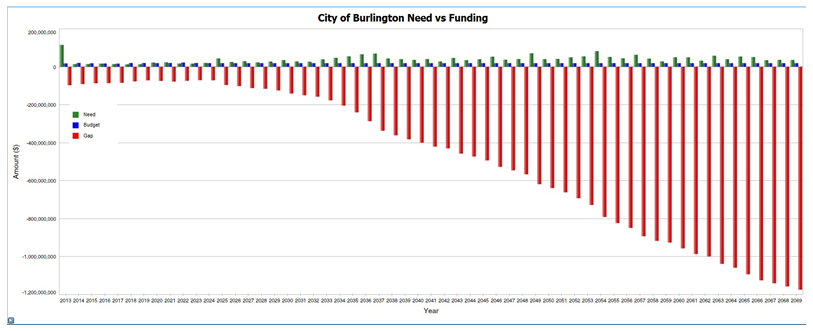 The chart covers a long period of time and it is difficult to read the detail but the trend isn’t hard to miss. Those red lines represent the amount of money the city does not have but needs to spend if roads and other capital assets are to be maintained. Are there efficiencies anywhere? Fielding will tell you that we aren’t in a desperate situation – yet, but he adds that if we don’t do something now – we will be in a close to desperate situation. The problem is with the asset’s the city owns.
In January of last year Fielding briefed Council corporate Asset Management Project. At that time Italo DiPietro and Paul Rohoman were seconded from Engineering to Corporate Strategic Initiatives to give the task the dedicated and focused attention it needed.
The city’s tangible capital assets, based on their replacement value is approximately $2.5 billion. Of this, approximately $2 billion is made up of linear assets including roads, storm sewers, bridges/culverts and sidewalks. A further $295 million is made up of city owned facilities and buildings. Collectively these two categories comprise approximately 92% of the city’s total capital assets as measured by replacement value.
 The objective of this project has been to report on the status of the city’s infrastructure, including adequacy of funding levels in the context of full life cycle needs. Following this, the project team would work with Finance staff on the analysis of funding scenarios and implications for the long-term condition of the city’s tangible capital assets. The objective of this project has been to report on the status of the city’s infrastructure, including adequacy of funding levels in the context of full life cycle needs. Following this, the project team would work with Finance staff on the analysis of funding scenarios and implications for the long-term condition of the city’s tangible capital assets.
In the asset management world seven things matter:
1. What do we own and where is it? (Inventory)
2. What is it worth? (Costs and replacement rates)
3. What is its condition and expected service life? (Condition and capability analysis)
4. What do we need to do to it? (optimum preventative maintenance and rehabilitation)
5. When do you need to do it? (Capital and operating plans)
6. How much will it cost?
7. How do you ensure long-term affordability? (Short and long term financial plan and acceptable risk)
These are large numbers. This is arcane language – only something an account would get excited about. However, if one looks at the data in a format that is easy to understand it evokes an Are you kidding me?
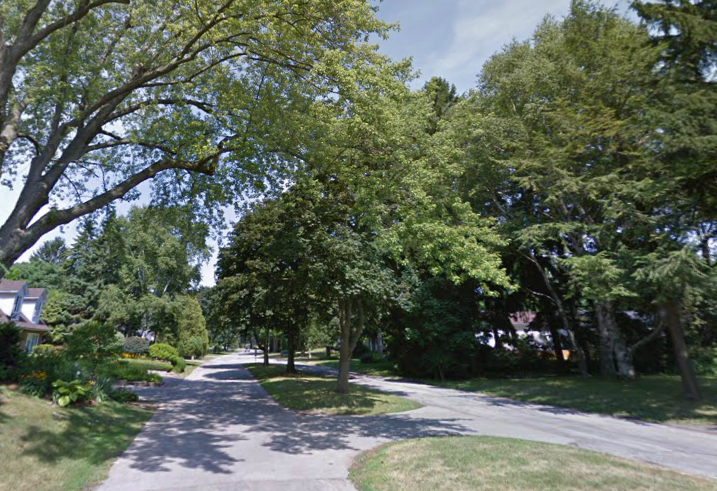 Goodram looking north from LAkeshore: a classic Burlington Street that cost $2.9 million to rebuild just a portion of the street. Last summer Goodram Street was rebuilt. The street was close to 60 years old and its best before date had passed – some time ago. So the city rebuilt the road, rebuilt the sidewalk and the sewers at a total cost of $2.9 million
There were 54 homes on the stretch of street that had the construction work done. Based on the tax revenue the city derives from those 54 homes it will be at least 24 years before the $2.9 million has been recovered. In the meantime of course the city has to provide the good people on Goodram the normal services anyone else gets.
That kind of mathematics is just not sustainable – which is why Jeff Fielding and his staff are looking for more efficient ways to run the city. Somehow we must get a grip on what we are spending on the assets we own.
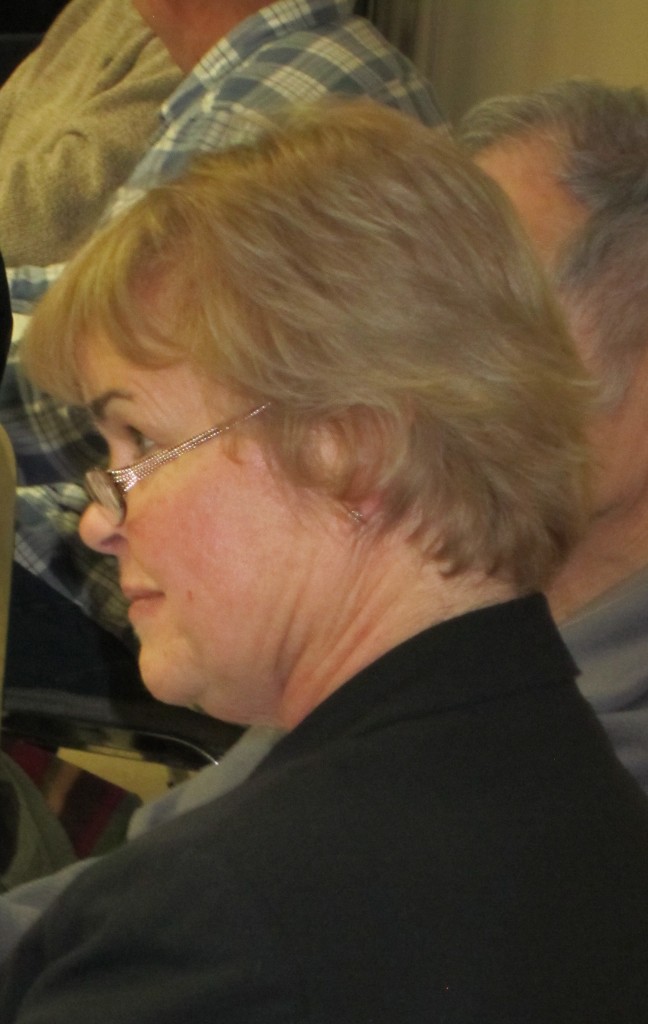 Director of Finance Joan Ford does a great job of providing the data and her department does a good job of collecting the taxes as well. It’s the spending side that is causing the long term financial stress. Ms Ford doesn’t do the spending. It is important to note, said a city Corporate Strategic Initiatives (CSI) report that asset accounting is different than asset management. The former is backward looking and is focused on developing an annual charge based on expected service life (amortization period) and depreciated cost based on the acquisition cost (net book value). It is not based on actual replacement cost or actual condition of the assets, and in many cases the actual inventory of assets has been pooled and does not give specific details on an asset itself. Asset management on the other hand is forward-looking and is focused on planning for the maintenance and renewal needs of an asset in the future. It is a management and capital planning methodology. Critical difference that impacts on the way Fielding has to find the money to pay for the replacements.
To provide a full long-term assessment of funding needs, a 60 year time horizon was used for both the facilities and buildings assets and roadways. Meeting new building code and accessibility requirements will add to the actual cost of projects.
 Based on this analysis, the existing backlog of now needs for facilities and buildings is estimated at $13.2 million. With existing funding levels a moderate backlog is forecast to persist on average over the next 25-30 year period. Based on this analysis, the existing backlog of now needs for facilities and buildings is estimated at $13.2 million. With existing funding levels a moderate backlog is forecast to persist on average over the next 25-30 year period.
In the longer term, the forecast for facilities is shown to increase significantly, as long life building systems reach the end of the useful life. The extent of the cumulative backlog will be approximately $25 million at the end of the planning horizon approaching year 60.
Ouch!
The existing backlog of now need roads has been calculated at $105 million. The shave and pave program has extended the life of our roads but there is nothing that can extend them forever. Existing funding levels indicate a major deficit in approximately 2025 which is when a large volume of roads that will be at the end of their useful life and will require full reconstruction.
One of the objectives in the City’s Long Term Financial Plan is Predictable Infrastructure Investment. The city’s infrastructure is aging, and funds must be committed to ensure it is properly maintained and renewed. It is imperative that a strategy be developed in a way that ensures our assets are protected and maintained at minimum cost to the taxpayers.
There are several possible financing strategies available to address the issue of the existing backlog and the growing infrastructure funding gap. Capital from Current funding (Cash) is one of the preferred strategies. It requires detailed planning to ensure that funds can be collected over the life of the asset. . This option would require incremental increases to the city’s existing dedicated infrastructure levy. This would directly impact tax rate increases as well as restrict the ability to utilize property tax levies for other needs.
That last sentence needs to be read a second time. `… require incremental increases to the city’s existing dedicated infrastructure levy. This would directly impact tax rate increases as well as restrict the ability to utilize property tax levies for other needs.
Funds for new project would not be available.
In order to move towards a cash-based renewal program there may be a need to reduce the speed by which the city achieves the optimal life cycle funding level. Lifecycle spending levels may need to be slowed down to match funding capability, and new initiatives and programs restricted to match available funding. Despite these challenges, the cash funding option is preferred due to its sustainability.
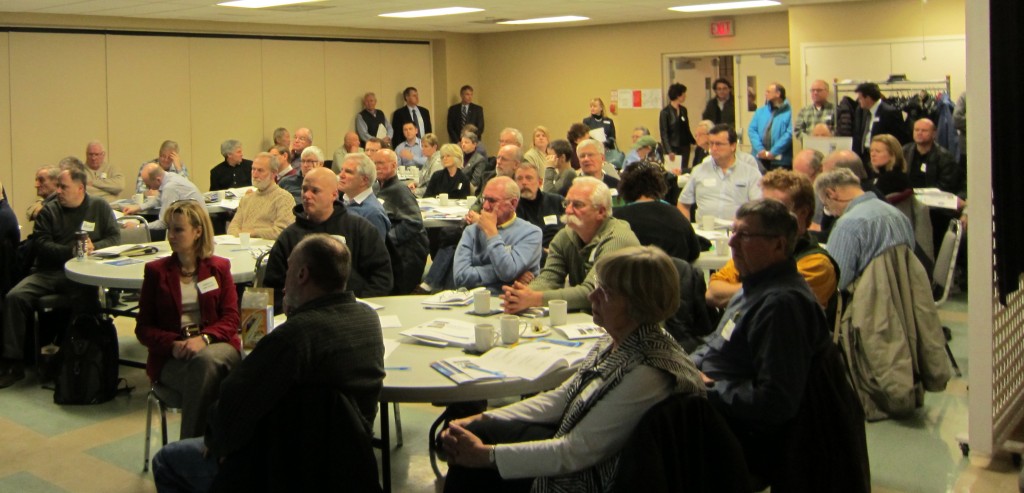 A rapt audience listened to an overview of the 2014 budget. What they have yet to have explained to them is the desperate situation the city will be in ten years from now if something isn’t done in the next few years to figure out how we are going to pay for the maintenance of the roads we have. The city`s reserve funds are improving but the city nevertheless got a “warning” rating when the last report was received.. Drawing upon reserves to fund infrastructure renewal will only be sustainable in the long run, if contributions are made on an annual basis from the tax base and other revenues.
Tax monies put into reserve funds is then not available for other projects.
As well, the city may want to establish a policy of maintaining a minimum balance on the capital reserve funds. This will allow the city to maintain financial flexibility and match funding required by other government grant programs without incurring additional debt.
The Parks & Recreation Department currently adds a surcharge on room rentals and programs at select locations. These funds are then held in a reserve fund for that facility’s capital renewal needs. The practice is not currently in place at all locations and the surcharge being collected is often insufficient to cover all renewal needs. The vast majority of other fees collected across the city are used solely to offset departmental operating costs and do not contribute to facility renewal. Should the city choose to rely more heavily on this source of funding, a review of current revenue policies would need to be conducted to establish where facility renewal costs could be recovered from rates and fees.
The city has recently been successful in the sale of naming rights at the new Haber Community Centre. Annual revenues from this sponsorship arrangement will be deposited in the facility’s reserve fund to be used towards future capital renewal. Additional private sector sponsorship arrangements such as these could be used to address facility renewal at other locations within the city. It should be noted that these options only address the city’s facility infrastructure needs and do not assist with the funding gap for other asset categories.
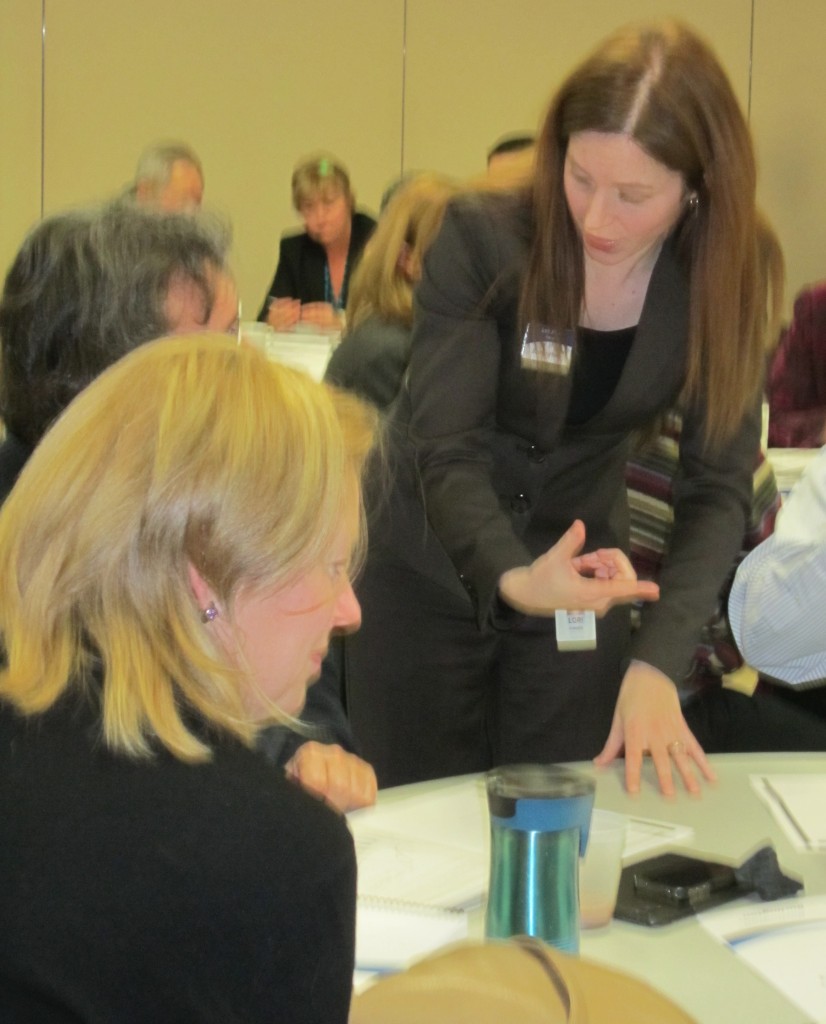 Lori Jivan, Acting coordinator of budget and policy patiently leads people through an explanation of the budget and the workbook the city created. Debt financing is beneficial as it can be used to address immediate needs faster than waiting for cash reserves to be built up. However it comes with an additional interest expense. Debt follows the principle of “intergeneration equity”, as it spreads the costs over the taxpayers consuming the asset and the benefit of the capital project over a longer period.
The city has a current debt policy which restricts total debt charges to 12.5% of net revenues.
The city’s long term reliance on debt as a funding source for asset renewal should be phased out as asset renewal is a continual expense requiring a sustainable funding source. However, it may be necessary to incur debt financing in early years in order to include several critical life-cycle projects for which sufficient funds have not been fully set aside. It is also important to keep in mind that when considering the use of debt as a funding source, the city should ensure that it is being used in a fiscally responsible manner and should follow the recommendations of the City’s Long Term Financial Plan.
Other options are:
Divesting of underutilized assets – This option would include the review of assets owned by the city (land and buildings) with the objective of maximizing the value of these assets through sale, partnering on development or optimizing net lease costs received/paid by the city.
Development of other revenue sources. There is a potential to develop other revenue sources through the establishment of city owned development or service corporations.
 Transferring of assets to senior levels of government, for example roads rationalization with the Region. Transferring of assets to senior levels of government, for example roads rationalization with the Region.
Burlington is not bringing in the new employment development. Commercial properties pay more in the way of taxes and cost the city less to service. Residential housing is a loss operation for the city: it costs more to provide the services home owners need than the city is able to collect in taxes.
 Can the city manage its debt and the cost of the infrastructure by pushing some of it forward and having the next generation pay for some of what we need to fix in the next ten years? Could the city use a conversation that would look seriously at the options in front of us? There is one more graph that offers some hope. We continually hear about the baby boomers that are going to retire and cost the city more to provide services for.
The chart above shows where the hope is. While there are millions of baby boomers there are even more millions of Millennials – young people who will want to live and work in Burlington. We need to ensure that there are jobs in the city for them and that Burlington is a city they will want to live in. But that`s 20 years down the road.

 By Pepper Parr By Pepper Parr
January 30, 2014
BURLINGTON, ON.
The public got their first chance to see real detail on the proposed 2014 budget. It wasn’t that they didn’t like what they saw – they said they didn’t see enough data and they wanted a chance to talk about the budget before numbers were put out.
A packed room of about 70 people went through a workbook and talked about what they liked and didn’t like. On balance they were prepared to live with the proposed budget – there were the usual few who didn’t want the city taking another dime out of their pockets.
The LaSalle Park Marina Association tried to tilt the scales and had one of their advocates at each of the discussion tables.
Vanessa Warren of the Rural Coalition went to the front of the room and asked the “special interests” refrain from that practice.
In her summation she pointed out that none of the remarks made at the only public meeting being held on the budget would be available before delegations were made. The sense seemed to be that they wanted more information and they wanted it sooner so they could have a real impact.

 By Staff By Staff
BURLINGTON, ON.
January 23, 2014
You write them a cheque for times a year. It’s not exactly chump change. It’s just one of those things one does in a civilized society. You pay taxes and expect value for money.
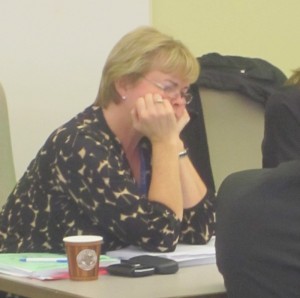 Joan Ford, the city’s Director of Finance knows where every dollar comes from and where every dollar gets spent. The city will be putting most of its Finance department people on the front line next Wednesday at the Burlington Art Centre. No open bar but there will be coffee and cookies while you participate in a public consultation meeting and interactive workshop on the budget.
The city wants you to tell them what is important to you. They do this each year and the turnout is not bad. They do an overall presentation and then run small, staff-led work groups focusing on such topics as service choices, infrastructure and planning for the future.
In a nut shell this is what the 2014 budget is about:
The City of Burlington’s proposed 2014 current budget recommends a 4.13 per cent tax rate increase to the city’s portion of the property tax bill. When this is combined with the Region of Halton’s increase of zero per cent and an education increase of zero per cent, the overall result is a proposed property tax rate increase of 1.68 per cent or $15.08 for each $100,000 of residential urban value assessment.
There are a couple of things that could be done to make this more effective. Putting a document on-line that can be downloaded and printed that sets out the basics of the budget so that people can do some homework if they wish. The budget is there if you want to download all 254 pages and print them out. How about something that is say 10 pages with lots of graphs?
And why this event is always held at just the Burlington Art Centre is inexcusable. While space is limited at Tansley Wood a public meeting could be held there and with the Alton Campus now open a public meeting could be held there as well.
The Burlington Gazette has been following the development of the budget for 2014 closely. Links to what we’ve written appear below.
 Most of the council members hold meetings in their wards to get local input. A couple of Ward 4 residents discuss a previous budget. Members of your city council continually say that half the population of the city is north of the QEW. City hall needs to do much more to serve the needs and interests of these people as well. This is a great opportunity for members of the public to share their insights, to learn more about the city’s proposed 2014 current and capital budgets and to discuss the impact the budget will have on property taxes.
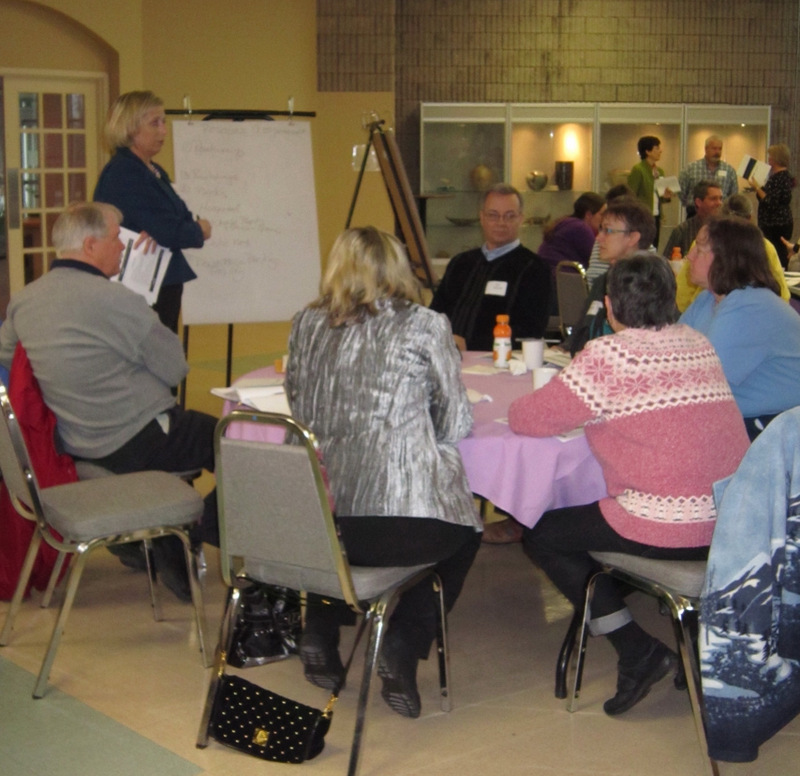 The small workshop sessions can be quite useful, particularly if there is something you want more detail on. Every Council member is on hand and anybody that knows anything from the Finance department is in the room. Wednesday, Jan. 29, 2014; 7 to 9:30 p.m.; Burlington Art Centre. Plenty of parking at the rear of the building. They should make the parking free on budget review nights.
This is an election year – so expect members of Council to listen with bigger ears this time around. Make your views known and let them know you will be watching.
If you can’t attend the meeting, watch the webcast on the city’s website and complete the online workbook If you’ve really got a burr under your saddle and have to talk to someone – a real voice can be reached at: 905-335-7600, ext. 7896.
Background links:
City manager tries to get some ground rules in place.
City administration begins to negotiate with Council on 2014 tax levy.
Will the 10% over four years hold; doesn’t look that way.

 By Pepper Parr By Pepper Parr
BURLINGTON, ON.
January 15, 2014
While Burlington’s budget is certainly not settled – the broad strokes are clear enough. The public will watch council members jockey for position and do some posturing but the basics are clear.
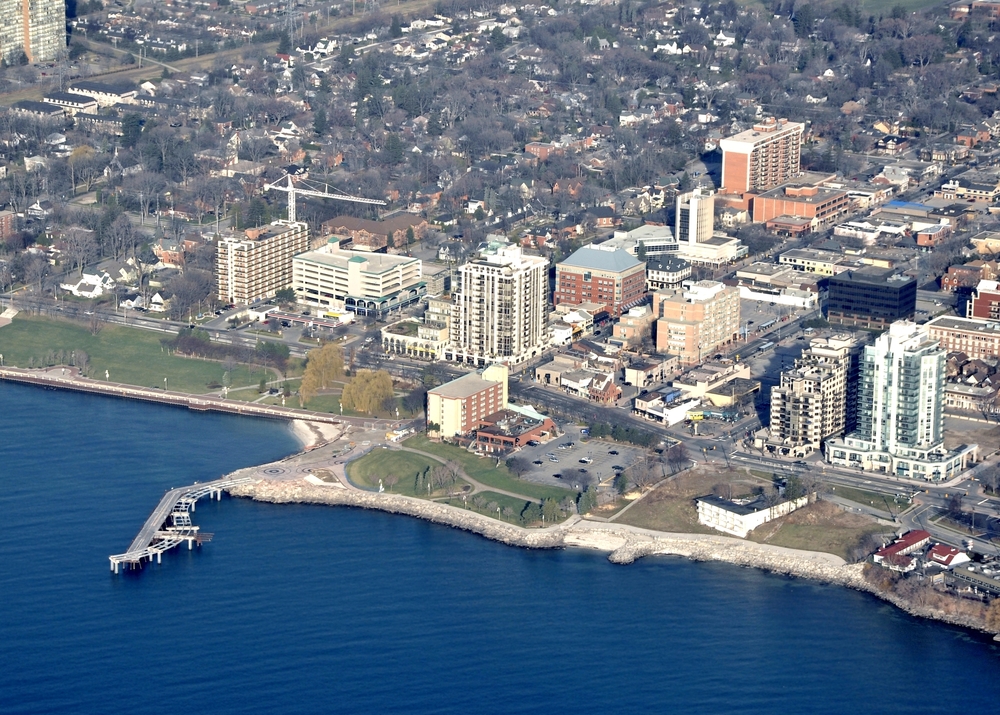 It’s quite a city. And for the most part it is well run. There is a strong case for putting more into infrastructure maintenance and not as strong a case yet for culture. Pushing back some of the capital projects a few years – grade separations on Mainway and Burloak are at the top of that list.
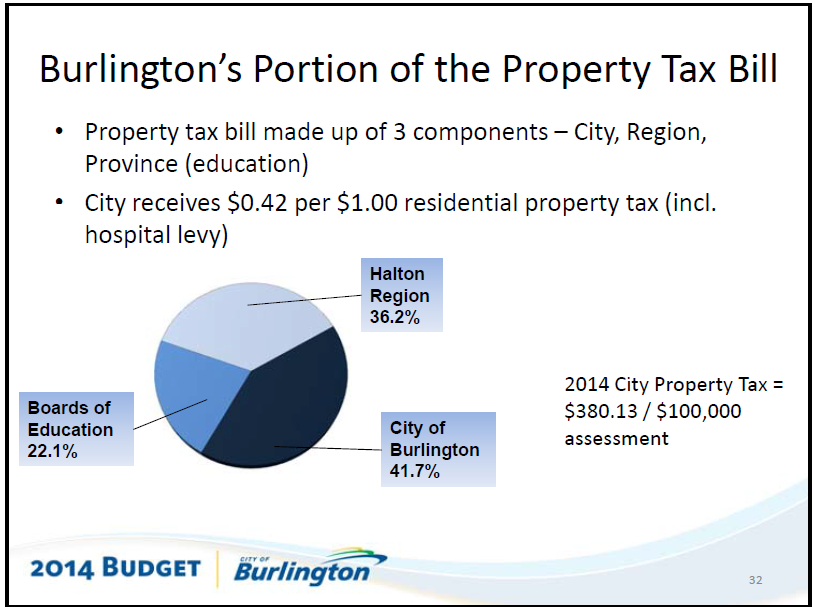 The tax bill the city sends you is for services provided by the school board and the Region which covers police, waste management and most of the social services. The Region has a billion dollar budget. The city collects for everyone and we send their portion along to them. Council will beaver away at the small stuff – next year they will be looking at a significantly different approach to the creation of the budget. City Manager Jeff Fielding talks of 2014 being a transformative year during which a specific staff member gets named as the owner of a service and works with the various departments involved in the delivering of that service.
The city is moving out of a departmental approach to budgeting to a service approach. It will take getting used to for many of the people at city hall.
Fielding is also taking a long hard look at the services the city is in. Should we be doing this is a question he will be putting in front of whatever the public elects in the way of a city council this October. That’s something you might want to keep in mind as you look over the talent that offers itself for public service.
For those thinking about running for office – being a member of city council is going to take a lot more in the way of intellectual capacity and it will be a lot more exciting from a career development point of view. Having just a pretty face and being a nice guy won’t cut it anymore.
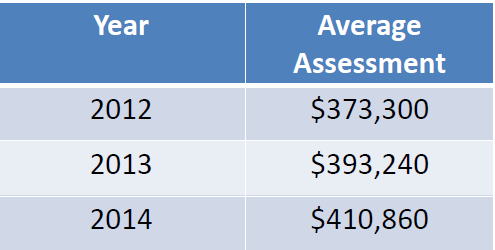 The average assessment of dwellings in Burlington. What does Burlington have in the way of an economic base – that is how many dwellings are there and what are they worth because it is this economic base that taxes are drawn from.
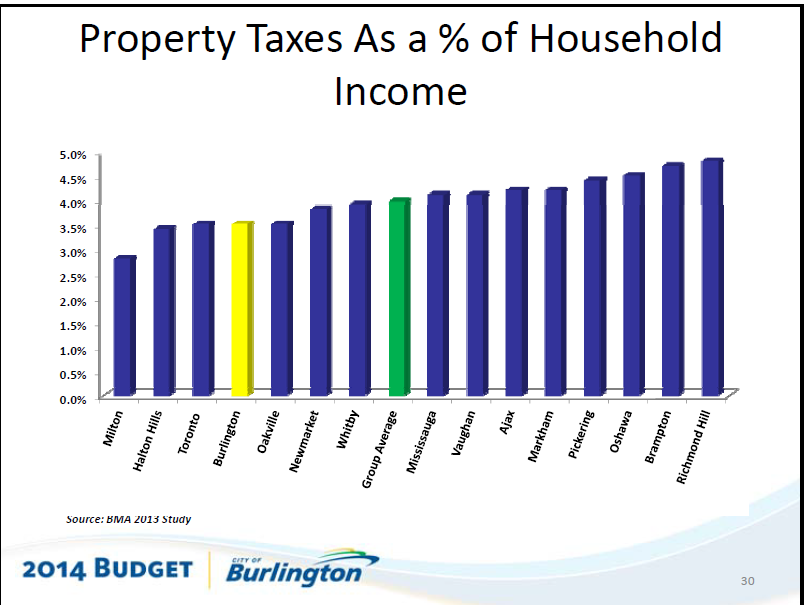 We spend less of our income on taxes than most of the comparable communities – but we are marginally higher than Toronto. What has Burlington paid in the way of taxes historically and what percentage of household income did those taxes s eat up? Are Burlingtonians spending a disproportionate part of their income on property taxes? We compare favourably with other communities in our part of the province and our size.
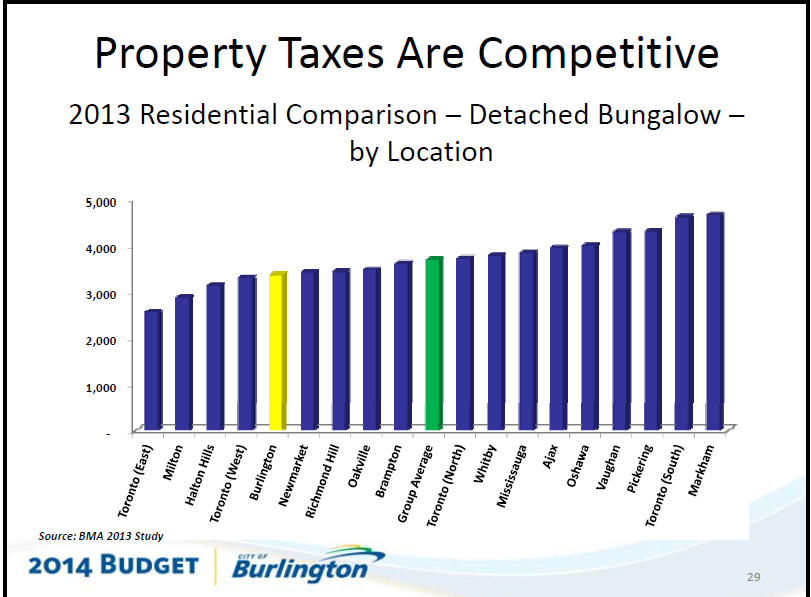 We are below the average in terms of property taxes.  Burlington is on the high side this year when compared with other municipalities in the Region. Last years Oakville was the highest. How does Burlington compare with other communities? People choose a community for is location and for the amenities it offers. Are the schools good schools? Are the parks and recreation services good. Are seniors a part of the community? Is this a good place to raise children? Are the taxes decent.
Is the community a safe place? Is it a caring community?
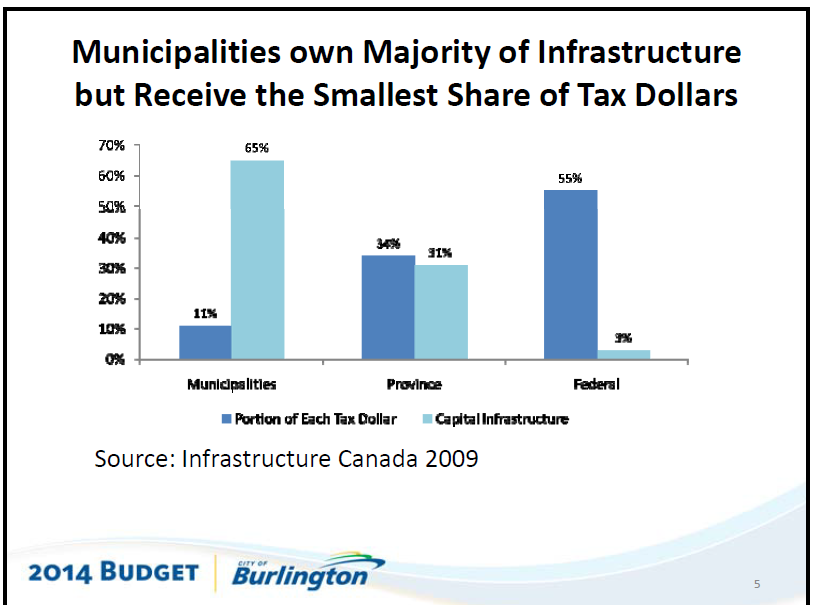 Those roads, bridges and libraries are all our to operate. We have more in the way of capital infrastructure than anyone else – and fewer dollars to pay for it all. And yet, for the most part municipalities make it work. Municipalities deliver the bulk of the services people use but they certainly don’t have the bulk of the tax revenue. They are also close to the bottom rung of the services food chain. Libraries, museum, swimming pools and ball parks along with ice arenas are provided by municipalities who operate under the rules set out by the province.
Background:
First look at the 2014 budget.

 By Pepper Parr By Pepper Parr
BURLINGTON, ON
January 15, 2014
There was a bit of a buzz in the Council Chamber Tuesday afternoon – the significant seven were gearing up for their first crack at the 2014 budget and given that they were going into an election year they both wanted to get it right and at the same time make sure they took care of the people in their wards.
Ward 3 Councillor John Taylor was the first one to approach the pork barrel – we will come back to that.
In a phrase – the city wants to spend $134,513,000 – up $2, 155,000 from 2013- and they are going to do that without adding to the staff compliment which now sits at 1311 with both full and part-time people. Staff salary increases is to be limited to 1% in 2014.
The document being debated was the recommendations from the city’s Executive Budget Committee (EBC) which consists of the city manager, his two general managers, the Director of Finance Joan Ford, Transportation Director Bruce Zvaniga, HR Manager Roy Male and Corporate Strategic Initiatives Executive Director Allan Magi.
At a meeting in December city manager Jeff Fielding put a number on the table that had his people looking for an increase that was 4.66% over 2013 or $6,106,ooo – you could almost hear the gulping on the other side of the horseshoe.
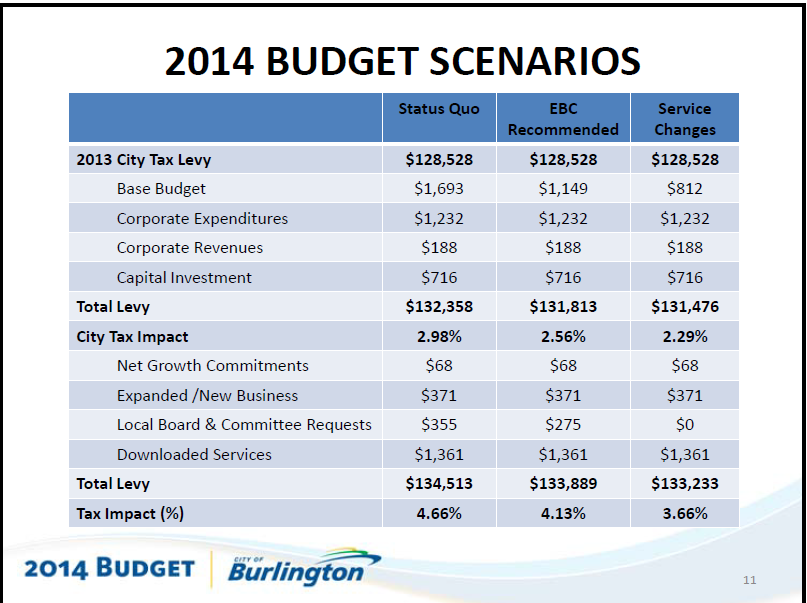 City staff came up with a budget increase of 4.66% over 2013. Council pushed back and it was cut to 4.13% Service changes could add an additional 3.66%. The city has a couple of whoppers it has to deal with. The money it has to fork over to OMERS to cover the staff pension requirements got increased – taxpayers don’t get to say “no thanks” to this ask. OMERS found it wasn’t fully funded to meet the draw hat would be made so they slipped in a special levy.
Insurance premiums have increased and there has been more than expected in the way of assessment appeals that were lost and vacancy rebates.
The city’s infrastructure work is not up to date and more money is needed to fix the roads before they become so bad they have to be rebuilt. There is a half a percentage point ($643,000) tax levy dedicated to infrastructure that the city manager wants to raise to three-quarters of a percentage point.
Being added is $815,000 in spending which will get covered by additional revenue from the growth of assessment revenue.
Hayden Recreation Centre will get $375,000
Alton Library $295,000
Transit service for Hayden High School – this one won’t be a forever cost if the service is not well used.
Operating costs for water play features in three community parks: $49,000
Roads, Parks and Information technology growth: $52,000.
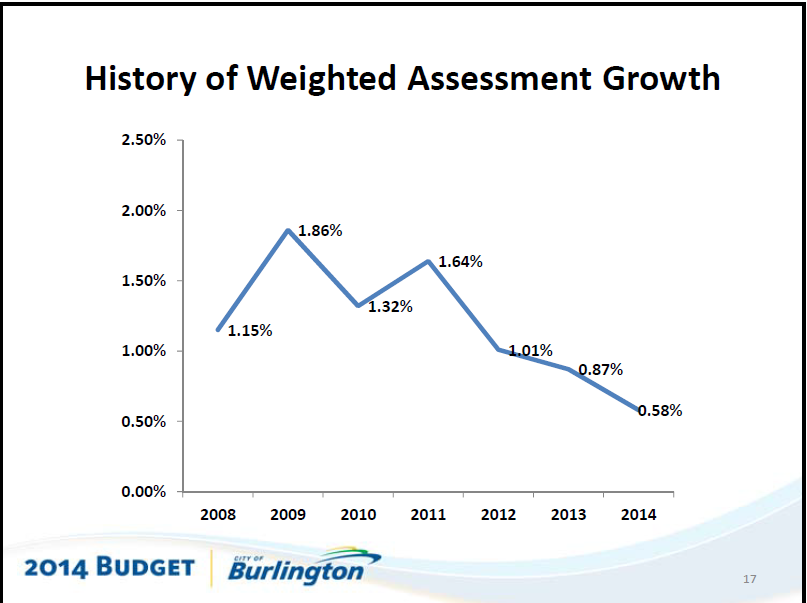 Growth in the city’s property assessment has come to an end. The spending days have to come to an end as well. The gravy days for Burlington are now at an end. Assessment growth has plummeted. In 2002 the weighted assessment growth was 3.69% – we are now at .58% The big cheque days for the developers has come to an end.
The Executive Budget Committee recommended four areas for expansion: Heritage is to get a full-time Planner – if the Heritage Conservation District gets approved in principle that planer will be very busy.
Heritage Burlington will get $167,000 of which $64,000 is a onetime amount.
Culture has been given a lot of attention; the Cultural Action Plan has been approved in principle – next step for that is an Implementation plan which will require a full-time Manager of Cultural Services (think $128,000) and lastly $36,000 for the community garden initiative Burlington Green got off the ground two years ago. Agriculture has worked itself south of the rural urban divide.
The Burlington Economic Development Corporation is in for $275,000 for more studies – they want to revise their business model – what business? That crowd has delivered one cock-up after another in the past two years. They turfed the Executive Director and then added a significant chunk of change to the cost of the severance package with some ill-timed comments from the chair. The movement of that mouth is reputed to have cost the city an additional $10k.
The city feels it needs to add crossing guards and an additional crossing guard supervisor to the staffing list. And the final increase to the tax levy for the city’s portion of the cost to rebuild the Joseph Brant Hospital is due to come on-line this year.
There is also a service called One Call that the city can’t get out of which is going to cost us $111,000 this year and probably an ongoing amount for the service that has to do with knowing where anyone is going to dig to ensure that they don’t hit hydro lines, gas lines or anything else that is underground. when the service was mentioned at a Council Stranding Committee meeting Roads and Park Maintenance Director Cathy Robinson said there wasn’t much the city could do – it was being mandated by the province and we were stuck with it.
Looked at from a high level – the budget for 2014 looks something like this:
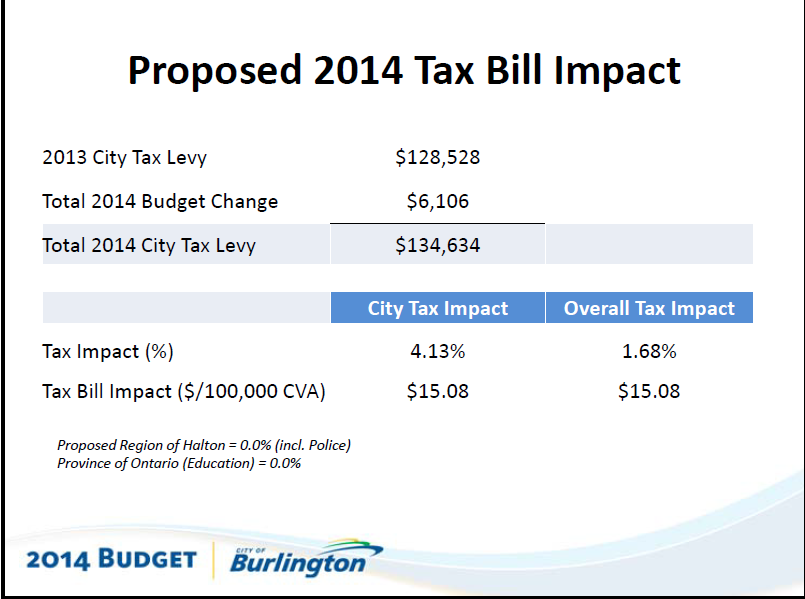 This is what the Executive Budget Committee proposed to Council early in December. City Manager Jeff Fielding called it a status quo budget. Council wasn’t quite on for that much. Staffing has held firm: 1131 people of which 865 are full-time and 251 part-time – holding those numbers in an election year is no small feat. Kudos on holding that line.
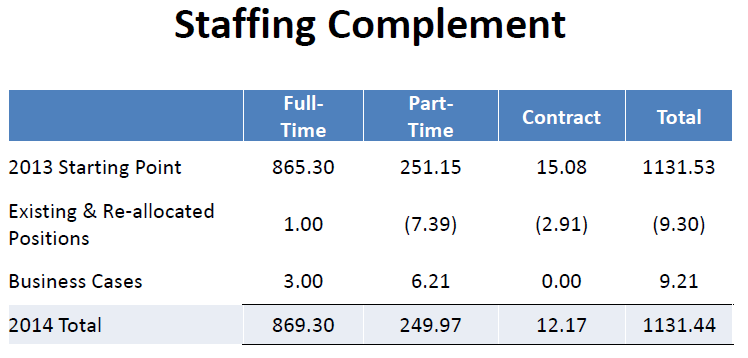 Staffing was kept at the 2013 compliment and salary increases will be limited to 1%. That will keep the rate payers happy. While not included in the Executive Budget Committee recommendations there are some suggestions Council can consider if they are looking for ways to cut the budget.
Limit overtime
Remove one leaf pickup south of the QEW ($65,000) and one north of the QEW ($70,000)
Revise the sidewalk snow plowing program ($27,000(
Convert 10% of the passive parks to naturalized areas ($24,000)
Eliminate enhanced maintenance of grass sports fields ($40,000)
A reduction in the bus cleaning contract ($100,000)
Staff provides a business case for each of these options which will get debated at the budget meetings.
Council members are currently going through the budget books, line by line for some of them, and picking items they want more information on. They then write-up short notes on items they wish to debate. When all the requests are in they get debated. It is at this point that Council members push for their pet projects and where they take positions they will want to use in the forthcoming election.
Each has to figure out where they are with their electorate. If you were wondering why none of the Council members, except for the Mayor, has yet to file nomination papers, perhaps this will help: once you file papers you are in the race and you have to begin taking a position on matters. And the budget, which determines the taxes people will pay, is a major matter.
When the budget is decided upon watch for the different political positions to become evident. Ward 2 Councillor Marianne Meed Ward, who chaired the Budget meeting was sounding much more “financially fluent” than she normally does, may begin her 2018 campaign for Mayor if the budget fits her longer term agenda.
Will this Council save or spend? The city manager is turning out to be a bit of a spender – does Council want to encourage this approach?
There is $44,000 that can be saved from the tax levy if the transit service for the Hayden High students is paid for out of the Provincial Gas Tax funding – these are monies , gas taxes, the province passes along to the municipalities.
The Fire department wants four more firefighters ($361,000); a proposed increase in the dedicated Capital Infrastructure Renewal levy from .50% to .75% would add $964,000. Not being recommended for this year.
Community Development Halton is in for $86,000 – Ward 3 Councillor John Taylor is pushing hard for this one. He will probably get his way; what he is prepared to give to get his way is unknown.
Sound of Music wants $44,000 – they argue that they bring in tons of spending to the city. Taylor wants to see their books – again, before he gives them as much as a dime.
The Museum Board wants a Special Events Assistant ($36,000)
Other places to spend that are also not recommended by the EBC include:
Restoring Transit resources: $1 to $2.8 million.
Increased money for storm response $747,000
Phase in the OMERS contribution which would stretch out the length of time we have to pay that big lump sum charge they hit the city with.
Jiggle the amount of money we take as a levy for the hospital will cut $300,000 this year but that amount will have to come from somewhere next year.
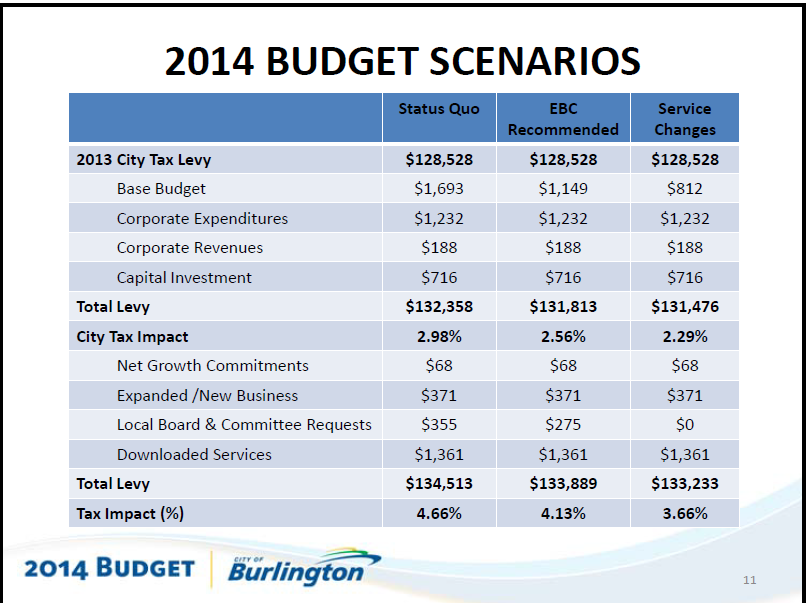 City manager wonders why so much time is being spent over a half a percentage point difference in budget proposals. Is it worth a full month of expensive staff time. It’s called DEMOCRACY people having their say. If you look at budget scenarios chart again you will see that the difference between what staff first proposed, the status quo number, and what they came back with after council pushed back, is less than half a percentage point. What’s the big deal – live with it, it’s not a lot of money and the city has healthy reserves with debt permitted at 12.5% of net revenue currently at 8.4%
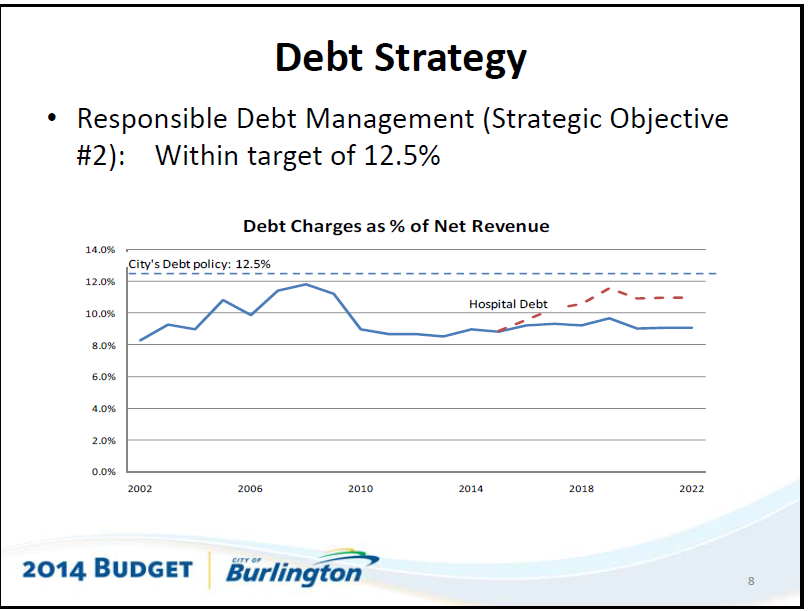 Having to find an additional $60 million to pay for the hospital upgrade pushes Burlington close to its self-imposed debt limits. The hospital levy does edge us very close to that 12.5% of net revenue debt level – which is self-imposed – the province would let us go to 20% +. What neither staff or council underline is that the hospital levy will continue to come out of taxpayers pockets – they will just call it something else.
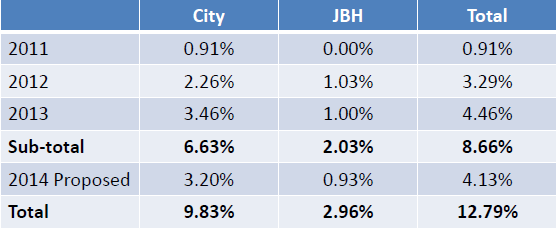 Tax increases each year of this term of office. Comes in at more than the 10% Mayor Goldring promised. Watch for an explanation as to what he really meant when he made the promise. But look at the chart with the tax increases each year of this term – that’s where the real story on this budget is. In the first three years of the term tax increases totaled 6.63% – add in the 3.20 proposed for 2014 and you get to 9.83% over the four-year term, which keeps the tax increases below that magic 10% number the Mayor, and truth be told, most members of his Council hung their hats on. Add in the 2.96% we are scheduled to give the hospital and we are at 12.79%
Now Council members will say, frequently, that the hospital levy doesn’t count – but it does because what is now the hospital levy is never going to go away. They have plans to spend that sum right through till 2031 and beyond. When bureaucrats get their hands on a portion of your money – they don’t let it ever get back to you.
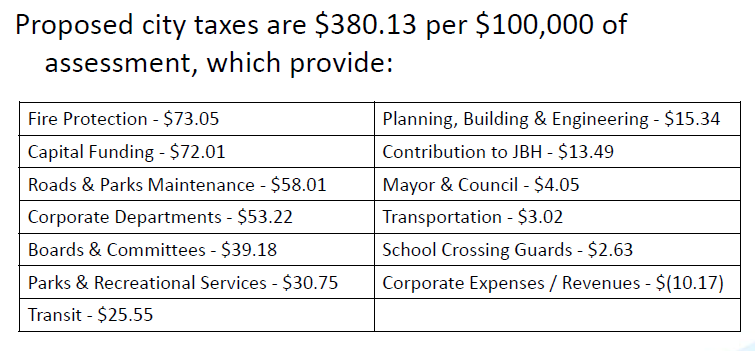 Assuming the proposed budget gets passed – and that isn’t an assumption you want to bet on – here is where your tax dollars are spent. The first time Canadians were hit with an Income Tax was to pay for World War I – and we’ve been paying an income tax ever since. The hospital levy is money that will always go to the city – get used to it.
It was a full session, the Community and Corporate  Services Committee got through the high level overview in close to record time. You could almost see the Council members feeling their oats. Services Committee got through the high level overview in close to record time. You could almost see the Council members feeling their oats.
The one area that sort of threw Council members was the comment from the city manager on the amount of time being spent on the budget. He wanted to see as much as a month taken out of the process, arguing that far too much staff time is being taken up with relatively small amounts.
What the bureaucrat forgets is that those small amounts represent a service that people expect and want some say in.
City Manager Jeff Fielding pointed out that the Region has its budget wrapped up in December and that Burlington will still be at it in the middle of March.
The Region has a billion dollar budget Fielding points out – but, as Mayor Goldring pointed out – they don’t have the public delegations that municipalities have. Also Burlington basically packed it in early in December.
Councillor Taylor didn’t like the idea of the time spent on the budget being shortened. He pointed out that the budget books were just given to them last Friday.
The schedule right now calls for the Capital budget and the Current budget to be handled at different times. It was suggested both could be done at the same time which would cut out a few days.
Comments from the bureaucrats suggesting that the politicians spend less time on how they spend the dollars they ask citizens to pay in taxes are a hint that perhaps the political process isn’t fully understood or appreciated by the bureaucrats.

 By Pepper Parr By Pepper Parr
BURLINGTON, ON.
January 8, 2014
The city will get its first peak at the budget for 2014 next week when a Budget Overview is given to the Community and Corporate Services Committee.
Burlington has revised its Standing Committee, renamed them and set up a schedule that allows for meetings during the day and in the evening when it is easier for the public to attend. So far however, there don’t appear to be all that many evening sessions.
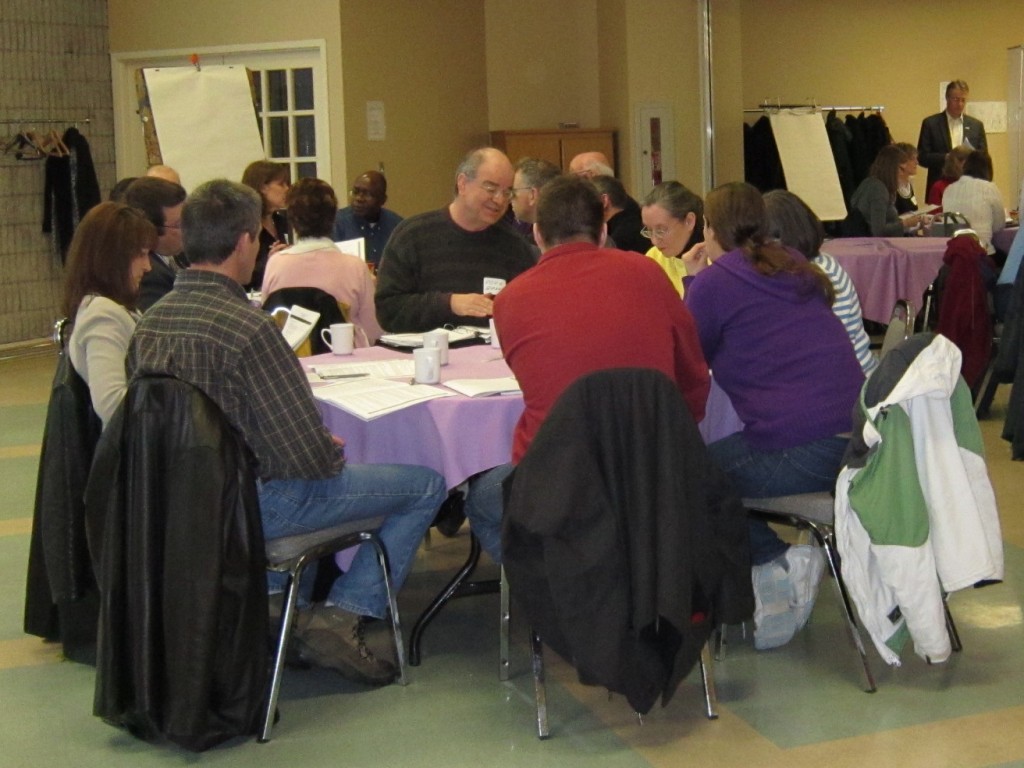 Citizens diligently reviewing the city budget. Do these public events ever result in any change or are they just a one way flow of information: From them to you. The public will get a chance to get an up close and personal look at the budget document on Wednesday, January 29th when there will be a Community Meeting and Workshop on the budget at the Shoreline Room at the Burlington Art Centre. 7:00 to 9:00pm – no open bar.
These public meetings have always taken place “downtown” partly because there wasn’t a decent location north of the QEW. With the opening of the Alton Campus there is no excuse for not holding a second meeting in that part of the city. Attendance will be small but once people in the northern part of the city are told, in a meaningful way that they matter – the public will turn out. And the city will get a point of view they don’t get south of the QEW.
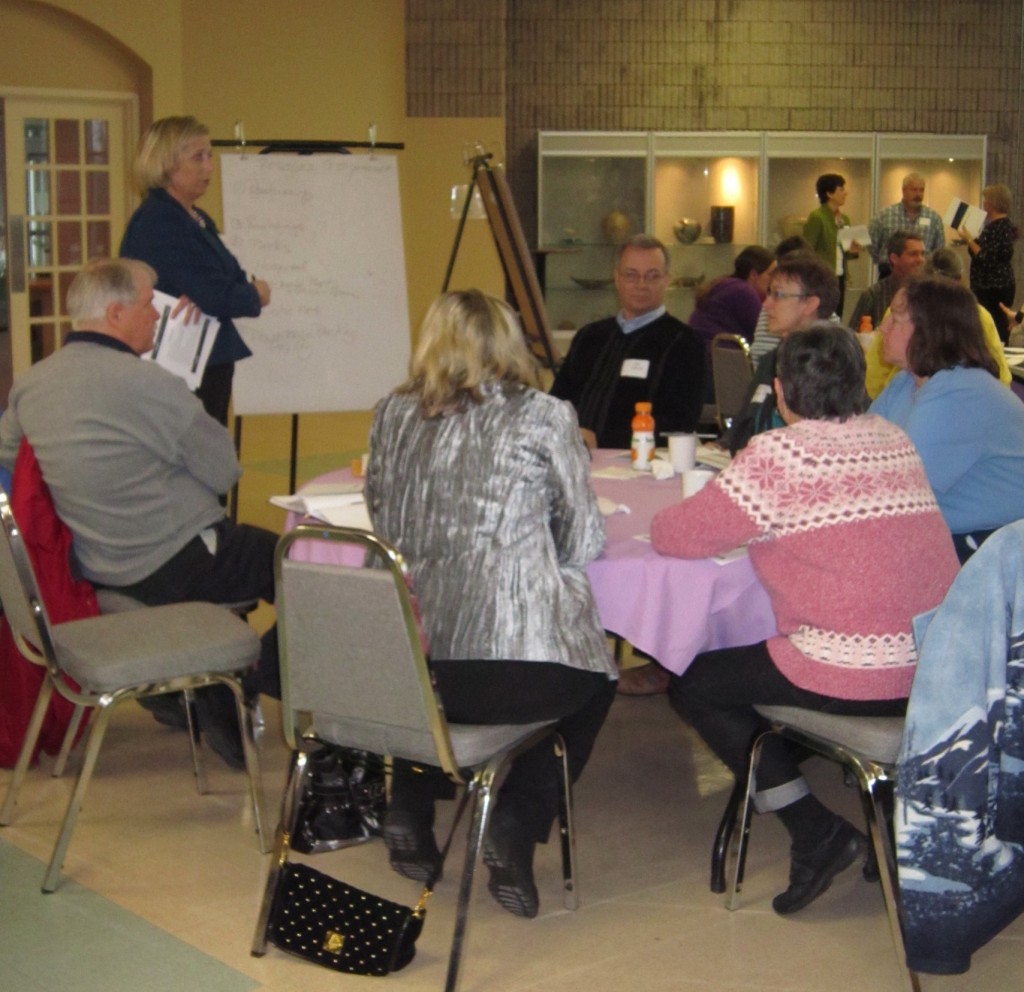 Senior staff facilitate the budget discussions – dies what they hear get any further than the flip chart? And will the city hold public meetings on the Alton Campus? Burlington’s budget is broken into two parts: Capital expenses, things like road work, underpass construction (We won’t see any grade separation work done this year – Mainway and Burloak won’t be done this time around) and the maintaining of the infrastructure we have.
The city administration expects to get the Capital Budget & Forecast review covered and approved in a single session that will take place Tuesday February 11th in Council Chambers starting at 9:30 am. It will then go to Council for a formal vote.
Part two of the city budget – they call it the Current Budget – will be open for delegations on Thursday February 13th before the Community & Corporate Services Committee in the Council Chambers at 9:30 am.
Why this session is not being held during an evening session is very difficult to understand. If the city wants to encourage delegations – truth be told they don’t want to have to listen to a couple of dozen people taking their ten minutes at the podium and giving their opinions. This is how democracy works in Burlington – it is a recent change and not a healthy one. In 1947 Winston Churchill remarked in the British House of Commons that: Democracy is the worst form of government, except for all those other forms that have been tried from time to time.” We paid a very high price for the democracy we have – let us not piss it away.
Council expects to approve the 2014 Capital Budget & Forecast in the Council Chamber during an evening session on February 18th, when delegations can take place. But, because this is a Council meeting, delegations are limited to five minutes and, as the chairs of the Standing Committees always point out – the “heavy lifting” gets done at the Standing Committee level.
The Current budget, which will be quite controversial this time out will get debated in Council chambers by the Budget & Corporate Services Committee on the following dates: Thursday, February 20, Tuesday, March 4 and Thursday, March 6 (if required). All of these meetings are at city hall starting at 9:30 am.
 After all that “heavy lifting” at the Standing Committees the budget will go to Council for approval on March 17th. That event will be an evening meeting. After all that “heavy lifting” at the Standing Committees the budget will go to Council for approval on March 17th. That event will be an evening meeting.
During January Council members will have copies of the budget which they will review and advise the Clerks office of any items in the budget they wish to discuss in-depth. Each Council member fills in a form, the forms get put into a single pile and the Clerk’s office organizes everything so that Council can see which councillors want to debate which budget item.
In the past the city has held what they called a “budget bazaar” that had senior city staff gathering in a room, with each department at a different table so that Council members could go from table to table and discuss in detail a budget concern.
There are significant Current Budget concerns that will have to be addressed in the coming months. Based on the remarks made by the city manager in December it became evident that the city would not succeed in sticking to the promise to hold increase at not more than 10% during the term of office. Few Council members spoke of 10% as a target – except for the Mayor and he may have to live with that prediction.
Fielding, in his comments suggested that it was more likely to come in at 14%+ over the ten years. That is something Council will decide as it moves forward. The budget recommendations come from the desk of the city manager ever since he took that file from General Manager Kim Phillips.
Jeff Fielding did make it clear as well that 2014 is a transition year for the way the city develops its budget. He has brought in an impressive bunch of financial management tools that include Results Based Accountability, Business Process Management and Service Based Budgeting. These tools will result in a move away from the “silo” approach the city has worked with ; one that has each department working its territory when many of the services delivered involve several departments.
So – for 2014 the question is – will Council manage to stick with the 10% and trample a couple of planned changes – culture could be the place where the pinch gets felt; they want to add an additional full-time employee. What gets thrown under the bus? Has transit taken all the pounding it can handle?
Perhaps there is an opportunity to suck out a bigger dividend from Burlington Hydro. The ice storm may have eaten up any spare cash they happened to have in the kitty.
There is of course a bunch of “reserve” funds – piggy banks with money set aside for a rainy day. And an election year is seen as a rainy day.

 September 1, 2013 September 1, 2013
By Pepper Parr
BURLINGTON, ON. The Mayor went to Ottawa recently to schmooze with other Mayors and to bend the ear of Ontario Cabinet ministers who attended the Association of Municipalities in Ontario conference; an annual event.
 Mayor Goldring is a member of LUMCO – a subset of the AMO organization made up of mayors from larger cities. LUMCO – Large Urban Mayors of Ontario have a particularly messy and at times nasty issue that is difficult for them to harp on at home but one they need to come to grips with – and that is the rising cost of early responders. Mayor Goldring is a member of LUMCO – a subset of the AMO organization made up of mayors from larger cities. LUMCO – Large Urban Mayors of Ontario have a particularly messy and at times nasty issue that is difficult for them to harp on at home but one they need to come to grips with – and that is the rising cost of early responders.
Police, fireman and emergency services people are costing us a fortune but no one wants to come out and say that – one does have to get elected and suggesting we could get by with fewer police officers and fewer fire trucks and the fireman are back faster than a jack rabbit with what that will do to their response times.
All true – but the municipalities want some fairness and a lot of streamlining to the current interest arbitration process.
According to Mayor Goldring, who gets much of his data from AMO, between 2005 and 2010, salary increases for the municipal sector hovered around 5% while increases for firemen (not just men any more is it?) were 27%; police averaged 19% and EMS people saw increases of 41%.
Unsustainable and, according to Goldring “unfair”. The Mayor is quick to add that the city is well served by its first responders. That phrase could be turned around to read that the first responders are very well served by the city. There are many, many members of the fire department on the province’s Sunshine list – that document that sets out who earns more than $100,000 a year.
The fireman in Burlington, and we assume across the province, have figured out how to get their claims in front of the politicians and keep them there – and so far they have been successful. So much so that the current provincial government doesn’t appear to be in any hurry to change the way the salary game is played for these essential people.
 For the first year in some time a small delegation of firemen took part in the annual city budget public consultation. At the 2011 Burlington public consultation meetings on the budget the firemen attended as a group and sat at one table and ensured council members heard their story. Sometime later there were eight to ten firemen in the back row of city council chambers when the budget was being passed.
These are big guys and there is a threatening sense to ten or more of them being in one place. Firemen have as much right as anyone else to demonstrate to make their point; something they did very effectively for Dalton McGuinty when he was running for office the last provincial. Whenever he stepped off a bus there were two lines of firemen creating path for him – all wearing “Fireman for McGuinty T-shirts”, great optics and good on them for knowing how to get attention.
The municipal politicians who have to come up with the money to pay these men and women now have to pay very close attention and look for ways to get what Mayor Goldring calls for some fairness in the salary game.
 Burlington has a union contract with the firemen that has been ‘in the works” since 2011. “Some of these interest arbitrations can take as long as five years to settle” explains the Mayor. And all too frequently he adds, “the settlement is retroactive and there is no reason given for the arbitration decision made.” Burlington has a union contract with the firemen that has been ‘in the works” since 2011. “Some of these interest arbitrations can take as long as five years to settle” explains the Mayor. And all too frequently he adds, “the settlement is retroactive and there is no reason given for the arbitration decision made.”
The province’s economy is better today than it was in 2011 but it is still a little on the wobbly side. City council has to find the money to meet the arbitration decision and at the same time keep the other union contracts in line. All this, at a time when the gap between union pay rates and that available in the private sector is widening. Add to that the very significant pension plans that municipal civil servants have gotten for themselves and you begin to understand why politicians go gray – quickly.
With the province now being run by a minority government politics gets in the way with the Tories looking for whatever advantage they can exploit and the New Democrats doing everything they can to ensure their union members get and keep as much as they can. And the Premier wakes up every morning hoping she can avoid a confidence vote. Which may be the way the game is played at Queen’s Park but try and make that point at city council when the budget is being debated and the Mayor talks of his wanting to keep tax increases below 10% during the his first four-year mandate. If the arbitration decision comes in before the budget is made final, watch for a big gulp on the part of the people in the finance department.
In a letter Progressive Conservative House Leader Jim Wilson sent a letter to his counterparts he said that: “Exceedingly generous contracts being handed out to emergency workers through arbitration system, are forcing municipal leaders to choose between raising taxes and taking fire trucks and police cruisers off the road.” There was a hint of the possibility of some movement but it didn’t go much further than that. Adam Radwanski said in the Globe and Mail that: “To talk to the governing Liberals and the Tories since the letter was sent is to sense that they are once again about to demonstrate their complete inability to work together – overlooking past signs of common ground in the process.
 Did the Mayor manage to mention our first responder salary problems to the Premier while she was in town last Saturday? An obvious solution would be for the Liberals to introduce legislation this fall that would implement the arbitration changes from the 2012 budget, and for the Tories to support it. In an interview, however, Labour Minister Yasir Naqvi sounded disinclined to do that. The government’s focus, he said, is on bringing municipal leaders and emergency workers together to “develop consensus.” Other Liberals have echoed that imminent legislation is unlikely.
That the two parties are further from consensus on this issue than they have been in years can likely be chalked up to strategic calculations reports Radwanski.
“Both sides are playing with fire. Ms. Wynne is at risk of alienating key allies, such as Mississauga Mayor Hazel McCallion, who has been among those leading the charge for arbitration reform. And if Mr. Hudak is seen as an obstacle to changes rather than an effective advocate for them, that could cause grief for his largely rural caucus among mayors whose small towns are being stretched especially thin.
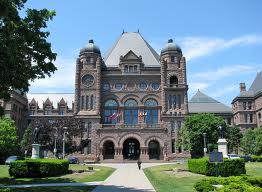 Voters will have to decide first who should run the province before any significant decisions get made. “If that is not enough to encourage co-operation, the simple matter of fairness should be. Even as the province had some recent success in freezing the wages of its employees, municipalities were getting stuck with double-digit salary increases in contracts awarded by arbitrators. As Mr. Wilson said in his letter, that is just not sustainable.”
Radwanski suggests that “By at least returning to the common ground they seemed to find last year, the Liberals and Tories could restore a tiny bit of faith in the minority legislature’s ability to address Ontarians’ needs. Instead, they seem poised to provide another example of its inability to do so.”
From a purely municipal perspective this is as good a reason as any to get on with a province wide election and determine just who is going to run the province – together the three stooges certainly can’t.

 By Pepper Parr By Pepper Parr
Each day a little bit more gets done. This morning, when we were told it was going to be a lot warmer than it actually was, four of the metal structures that will form the “beacon” at the top of the node that is on the pier were put in place.
It is something to watch as the crane helper move his hands to tell the crane operator where to swing the load that is at the end of the cable that swings the piece into place.
Riggers call this “flying” the pieces into place.
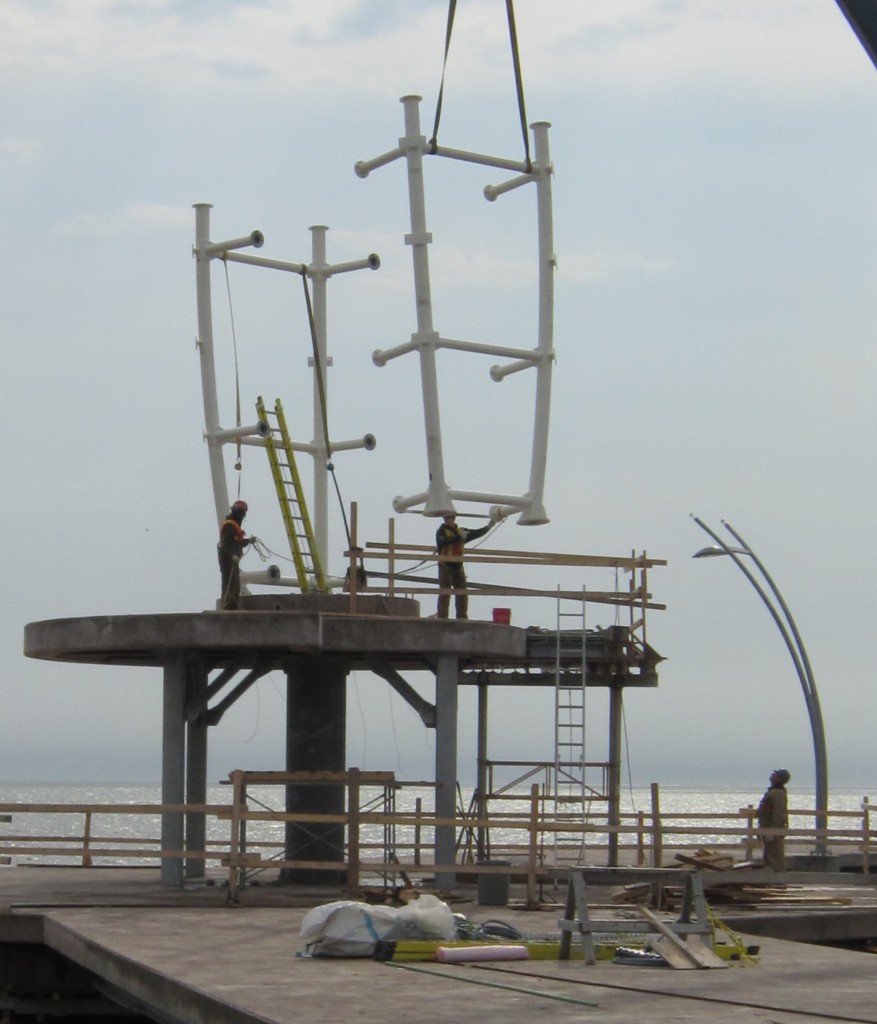 Two of four parts that will complete the beacon sitting atop the node on the Brant Street Pier opening during the Sound of Music Festival.  To ensure there is no damage to the pier, deck equipment with wheels have to wear socks. These came in in black with red sides.  Close your eyes for a moment and imagine what two metals ribbons going up each side of the pier with two bands of stainless steel painted Burlington blue – there really is such a colour. It will be absolutely stunning – expensive but stunning Late next week the first of the rails will arrive – they are going to be absolutely stunning. All the lights are in place, the beacon itself will get finished off next week and have its lights put in place as well.
The device – a self-operated little bucket crane was being used to complete some of the electric parts. What surprised some of the construction people were the “socks” the machine wore. They are in place to prevent the wheels of the machine from damaging the surface of the pier deck.
It won’t be long before the Burlington Teen Tour Band is marching out to the end and coming back in towards the city, flags flying and instruments tooting and banging away.
Hopefully it will be warmer.

 By Pepper Parr By Pepper Parr
Burlington, Ont., April 16, 2013 —Burlington Transit will be increasing fares, effective Wednesday, May 1, 2013. The increased fares will lead to extended services for transit users across the city. The increases were approved by city council in March.
Director of Transit, Mike Spicer advises that increases in ridership along many routes calls for extended services on these specific routes,”
 Will there be a reduction in the number of people who use the transit service when the new rates hit May 1st? Probably not – the people who use transit for the most part don’t have a choice. The following enhanced services will take effect on June 23, 2013:
Route 101 Plains Express:
New all-day service Monday to Friday
Minimum 30-minute frequency
15-minute frequency during peak periods
Additional stops at: Royal Botanical Gardens, Gorton Avenue, Howard Road and Francis Road
Routes 11 and 15
Saturday evening service extended to 10:30 p.m. and adding Sunday service on both of these routes
Northeast employment corridor – Monday to Friday midday by removing the current dial-a-ride Route 54D and extending Route 81 to cover this portion of Burlington.
Bfast, the Burlington transit advocacy group didn’t see the fare increase through the same rosy glasses.
Bus fares are going up 8.4% May 1st announces Bfast.
Is this because Burlington Transit buses are 8.4% more frequent?
Are buses 8.4% more comfortable?
Do they break down 8.4% less frequently?
Are they 8.4% more accessible?
Do these buses take us to 8.4% more places?
In short, is our Bus Ride 8.4% better? Is it worth 8.4% more money?
James Smith, part of the Bfast group said: “I think all informed observers would answer NO.
Smith, who might be a potential municipal candidate in 2014, he has run in the past, said: “The minor improvements outlined by city staff only go part way to restoring the service that was cut in 2012. These so-called enhancements were proposed by city staff in the budget process and are welcome However, these proposals were also proposed without a fare increase. This 8.4% fare hike has been called ad hoc, but I think of it as a cruel joke pulled out of thin air at city council without consultation”.
“In the March 13, 2013 Toronto Star article on the failures of transit in the 905 Mayor Goldring was quoted without a hint of irony as saying: “They (fare increases) should not be done on an ad hoc basis, … There should be some clear rationale.”
“Having listened very closely to city council on this subject I did not hear a clear rational for this ad hoc 8.4% increase. Some fees charged by the city have not gone up this year, others have. But I challenge the Councillors who voted for this increase to give us an example of one other city service fee that’s increased 8.4%.”
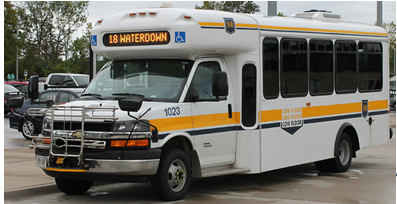 Burlington Transit does have plans to purchase smaller buses which will see more vehicles on the street and improve service. “In 2012 city council removed half million dollars gas tax money (earmarked for carbon emission reductions) from Burlington Transit and now use that capital to pave cul-de-sacs. Most cities use all of their gas tax money for transit. Burlington’s alone in the GTHA as we spend 80% of federal money meant for carbon emission reduction on increasing carbon emissions!”
“By 2015 the city of Burlington will have removed at least two million dollars from the transit capital funding and transferred this money to roads; talk about a carbon shift!”
“On May 1st Burlington will have the second most expensive Bus fare in the GTHA. Does this mean Burlington will get the second best transit system? The answer is no. By any objective measurement Burlington has arguably the worst system in the GTHA. Burlington has the lowest number of busses per 100,000 population, the oldest fleet, and the lowest operational spending per capita, so it is no wonder we also have the lowest number of people per capita riding busses of any GTHA municipality.“
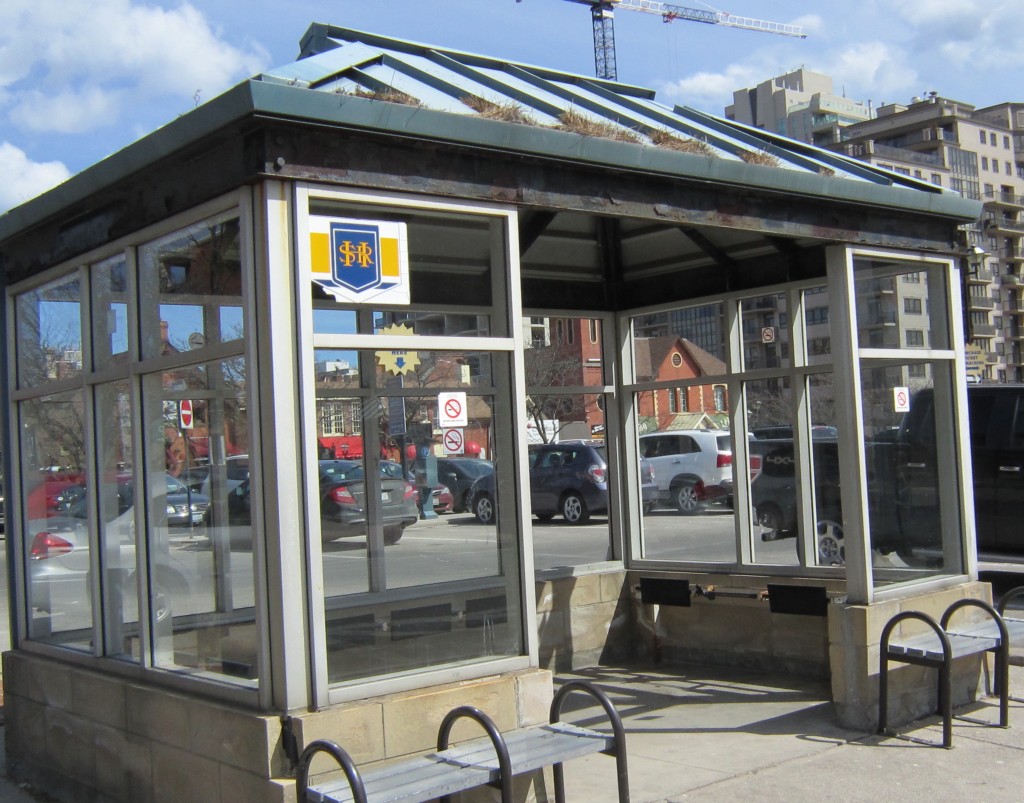 Suits won’t be seen in this bus shelter on John Street in the downtown core – they can drive to wherever they want to go. Those who don’t have that much income have to take the bus – and use this close to filthy bus shelter. The funding for road repairs has been so poorly managed in Burlington that the city now, according to Ward 1 Councillor Rick Craven, is short $18 million a year on the amount needed to get the roads to acceptable standards. Shadeland Rd in Craven’s ward certainly needs more than a “shave and pave”, the city’s current approach to fixing its roads.
Using gas tax revenue may be one way to move funding around but transit riders should not be expected to pay more and get less to keep the car drivers happy.
In comments to the Chamber of Commerce recently Mayor Goldring said “Suits in this city, don’t ride the bus.” Could that be because of the condition of those buses and the shelters along the bus route?

 By Staff By Staff
BURLINGTON, ON March 28, 2013 The following city of Burlington employees were paid a salary in excess of $100,000 during 2012. The taxable benefits(TB) paid are also shown.
 $100,000 does bring out a smile. The number of people on the sunshine list in the province increased by 11% over 2012. Some critics say that with the ever-expanding list, it might be time to consider raising the $100,000 threshold. However, Ontario Finance Minister Charles Sousa said Thursday the governing Liberals have no plans to do so and Premier Kathleen Wynne said that $100,000 remains a lot of money for most people.
Frank Ramagnano of the Toronto Professional Fire Fighters’ Union says he wants the government to bring the list in line with inflation — which would mean that those who made $100,000 in 1996 would have to make $140,000 today to make the list.
Armine Yalnizyan of Canadian Centre for Policy Alternatives says only a small fraction of workers in Ontario have salaries that exceed the $100,000 threshold. “In Ontario, she said, “ about six per cent of the population of tax filers have an income over $100,000,”.
The list was created by the Mike Harris government in the mid 1990’s.
ADCOCK, Alan, Firefighter: $103,120.56 Taxable benefit: $465.42
ALDHAM, Judy, Field Services Supervisor: $109,996.12 Taxable benefits: $1,849.56
ALLDRIDGE, Brian Platoon Chief : $123,328.88 Taxable benefits: $615.58
ANSELL, Daniel, Captain $113,321.01 Taxable benefits: $563.97
ANTONIOW, Phil, Manager Prg Dev, Budgets and Contracts: $109,032.48 Taxable benefits: $589.89
AXIAK , Rob, Manager Facility Operations and Special Projects: $100,706.66 Taxable benefits: $517.11
BAKOS, Michael Captain $110,541.90, Taxable benefits: $550.29
BARRY, Philip: Captain $108,934.31 TB $543.42
BAVOTA, Anthony: Deputy Fire Chief : $135,355.02 TB $1,803.63
BAYLOR, Mark: Captain: $112,179.98 TB $553.48
BAYNTON, Steve T: Captain: $113,327.35 TB $574.42
BEATTY, David N., Acting Fire Chief : $135,600.07 TB $7,988.79
BEDINI, Chris : District Supervisor: $100,408.00 TB $624.58
BENNETT, Randy: Mgr IT Infrastructure and Operations: $113,555.91 TB $614.11
BENNITT, James District Supervisor : $101,373.56 TB $787.70
BIELSKI, Bianca Manager Development Planning: $132,453.19 TB $714.42
BIRCH Charles T., Captain : $115,543.23 TB $563.97
BLACK, Jeffrey Manager Field Services: $101,181.82 TB $4,813.50
BOURQUE, Andrew Firefighter $101,930.99 TB $471.18
BOYD, Laura Manager Human Resources $101,769.05 TB $554.11
BRILLON, Sylvain Firefighter: $104,285.17 TB $465.42
CAMPBELL, Shawn Firefighter : $100,208.76 TB $465.42
CAUGHLIN, Deborah: Manager Council Services $103,761.11 tb $552.95
CHOLEWKA, Chris: Captain – $112,498.29 TB $529.88
COFFEY Peter Firefighter – $100,973.19 TB $469.49
COULSON, Ann Marie: Manager Financial Planning and Taxation: $126,435.63 TB $634.54
CRASS, John, Manager Traffic Services: $108,155.43 TB $578.50
CUNNINGHAM, Paul Firefighter $100,043.98 TB $465.42
DI PIETRO, Italo Manager Infrastructure and Data Management: $121,557.53 TB $636.90
DONATI , Derrick Firefighter: $100,317.10 TB $466.35
DOWD, Timothy, Captain: $115,724.49 TB $563.97
DUNCAN, John Manager Field Services: $116,822.29 TB $2,684.06
EALES, Mark: Captain $112,343.25 TB $536.60
EICHENBAUM, Toomas : Director of Engineering: $157,528.25 TB $853.97
EVANS Francis, Manager Halton Court Administration: $104,951.46 TB $558.37
FEDYSZYN, Blair Firefighter: $102,795.11 TB $465.42
FIELDING, Jeff: City Manager: $224,513.98 TB $8,180.96
FIORAVANTILeanne: Solicitor $101,899.65 TB $488.14
FLORESCO, Dennis W Firefighter : $101,283.09 TB $491.42
FORD, Joan Director of Finance: $149,510.39 TB $774.78
FRYER, E. Todd Firefighter: $102,610.17 TB $505.72
GLENN, Christopher: Director of Parks and Recreation: $128,983.69 TB $697.80
GLOBE, Darren Captain: $108,214.71 TB $547.92
GOLDRING, Patrick – Mayor: $165,487.94 TB $3,581.77
GRISON, Gregory J. Captain: $114,429.03 TB $563.97
GUMMO, Alan: Manager Planning Policy: $105,320.29 TB $425.82
HAMILTON, Scott – Manager Design and Construction: $107,399.35 TB $574.40
HAMMER, Chad Firefighter: $104,538.46 TB $488.81
HAMMOND, Bill – Fire Training Supervisor : $108,409.82 TB $542.10
HART, Timothy – Firefighter: $106,512.61 TB $465.42
HAYES, Dennis M. – Captain : $111,578.33 TB $550.29
HEBNER, Peter B. Captain: $115,106.42 TB $563.97
HUBBARD, Terry L. Communications Coordinator: $103,898.01 TB: $522.91
HURLEY, Blake: Assistant City Solicitor : $132,560.37 TB $614.11
JAMES Michael, Fire Training Officer: $105,012.61 TB : $551.52
JONES, Sheila. City Auditor :$116,471.99 TB $631.46
JONES , Stephen: Firefighter: $100,593.70 TB: $465.42
JURK, Robert, Senior Project Leader : $105,686.24 TB $561.13
KEANEY, Thomas: Firefighter: $101,774.29 TB: $480.90
KEARNEY, Jeff : Firefighter: $101,949.88 TB: $465.42
KELL, Donna, Manager Public Affairs: $112,368.90 TB: $606.78
KELLY JOHN Captain $110,613.43 TB: $550.29
KEYES PAUL Firefighter:$101,740.07 TB: $465.42
KOEVOETS, Matt – District Supervisor:$106,046.15 TB:$1,016.21
KRUSHELNICKI< Bruce – Director Planning and Building: $159,467.73 TB $867.66
KUBOTA, Erika – Assistant City Solicitor: $135,238.29 TB $626.80
LAING Bruce K., Captain: $105,084.49 TB $563.97
LANGFREY, Matthew, – Fire Prevention Inspector: $108,658.55 TB $487.30
LAPORTE, N. Jason Captain – $108,218.61 TB $536.60
LASELVA, John – Supervisor Building Permits: $102,639.24 TB $552.95
LONG, Mark – Captain: $112,539.49 TB $552.65
LUNN, Janet, Special Project Manager : $131,183.58 TB $851.29
MACDONALD, Gary- Captain: $113,960.30 TB $563.97
MACKAY, Michael J. Captain: $113,321.02 TB $581.78
MAGI, Alan Executive Director Corporate Strategic Initiatives: $172,528.52 TB $941.59
MALE, Roy E. Executive Director of Human Resources: $182,434.79 TB $969.01
MARTIN, Christopher Firefighter: $100,364.56 TB $465.42
MATHESON, Jamie – Firefighter: $104,841.92 TB $465.42
MCGUIRE, Chris, District Supervisor: $100,038.99 TB $598.04
MCNAMARA, Michael J. Captain: $117,004.75 TB $565.20
MERCANTI, Cindy – Manager Recreation Services: $110,893.12 TB $548.46
MONTEITH, Ross A. Platoon Chief : $126,490.82 TB $626.96
MORGAN, Angela – City Clerk: $131,055.36 TB $717.88
MYERS, Peter R. Captain: $113,321.02 TB $563.97
NICELIU, Kenneth Firefighter: $102,964.51 TB $480.04
NICHOLSON, J. Alan Captain: $113,338.47 TB $563.97
O’REILLY, Sandra – Coordinator of Accounting: $102,108.24 TB $545.45
PEACHEY, Robert. Manager Parks and Open Space: $111,618.36 TB $598.94
PHILLIPS, Kimberly GM Community & Corporate Services : $191,807.65 TB $8,905.30
POLIZIANI, Matthew Captain:$109,707.78 TB $536.60
REILLY, Peter Captain: $104,056.73 TB $549.57
ROBERTSON, Catherine. Director Roads and Park Maintenance: $142,399.25 TB $1,262.51
SABZALI, Karen – Manager Community Development Services: $104,156.92 B $472.17
SAVRNOCH, Gerald – Fire Prevention Officer: $102,158.47 TB $536.60
SCHMIDT-SHOUKRI, Jason – Manager Building Permit Services: $132,549.02 TB $714.42
SHEA NICOL, Nancy – City Solicitor & Corporate Counsel: $169,293.11 TB $773.56
SHEPHERD, Donna – Director of Transit: $169,473.73 TB $486.78
SLACK, Craig D. Platoon Chief: $127,255.77 TB $626.96
SMITH, Clint, Platoon Chief : $128,298.72 TB $626.96
SOMMERVILLE, Alastair – Firefighter: $100,458.05 TB $465.42
SPICER, Mike Director of Transit : $121,336.67 TB $636.87
STEIGINGA, Ron Manager Realty Services: $112,974.32 TB $602.18
STEVENS, Craig Senior Project Manager: $106,933.80 TB $533.13
STEWART, Scott GM Development and Infrastructure: $200,911.20 TB $11,437.68
SWANCE, Jeffery W. Captain: $113,321.02 TB $563.97
SWENOR, Christine – Director Information Technology Services: $151,878.74 TB $815.66
TAGGART, David Manager Facility Assets: $111,202.07 TB $578.58
TWISS, Greg Firefighter: $101,822.73 TB $491.42
WEBER , Jeff Deputy Fire Chief: $136,082.85 TB $5,589.59
WHEATLEY, Ryan – Captain: $107,971.44 TB $545.83
WIGNALL, T. Mark Firefighter : $104,971.00 TB $495.23
WINTAR, Joseph Chief Fire Prevention Officer: $112,343.90 TB $601.60
WONG Betty Controller and Manager Financial Services: $129,463.11 TB $700.73
WOODS. Douglas S., Captain: $117,582.74 TB $563.97
ZORBAS, Steve City Treasurer and Executive Director Finance: $221,352.61 TB $4,990.49
ZVANIGA, Bruce – Director of Transportation Services: $144,446.23 TB $749.37
Burlington reports that it has 1000+ FTE – full time employees. With 117 on the “sunshine” list that would have more than 10% of staff at that $100,000 plus level. That would seem to be somewhat higher than many private sector operations.
 If you’re happy and you know it – clap your hands. Are they worth it? Some of them are worth more than we pay them. Some are not worth what we pay them. Is there a difference between those overpaid on the private sector? Somewhat; but that is a function of management. Strong internal management with the willingness to weed out those that are not performing is what makes the difference. Burlington currently has a city manager that will not keep people that don’t deliver. The one drawback is that he has some people who have been there so long that he can’t afford to let them go – the “package” cost is just too high.
The city has frozen its staff compliment. If the city manager wants to fill a new position he has to close an existing job – no new staff. There are however contracts which overcomes that problem.
At a recent Chamber of Commerce breakfast Mayor Goldring told his audience that the city had a major concern with the salary disputes that were going to “interest arbitration. The Mayor complained that the hearing were taking far too long to be heard and reported and that most of the arbitrations were coming out on the side of the employee. “The capacity to pay does not appear to be considered” said the Mayor.
Compare the 2011 sunshine list with the one for 2012

 By Pepper Parr By Pepper Parr
BURLINGTON, ON. Marc h 28, 2013 It was almost sweet. The Community Services Committee was meeting to discuss a report on the upgrades being made to Lowville Park and talk about the revenue problems at Tyandaga Golf Club where a surplus of $75,000 just wasn’t good enough for Ward 4 Councillor Jack Dennison. On the agenda as well was a discussion about the Cultural Action Plan that is being worked up and on which we should see something more concrete later in the year.
What wasn’t on the agenda was a Memo from Councillors Dennison, Sharman and Lancaster who wanted funding for a pet project they thought had been included in the budget but was not.
Last year the city held two “car free Sunday event; one on Appleby Line and the other on Brant Street. Appleby Line was a limited success worth doing a again. Brant Street was not worth the effort, the time or the cost.
Councillors Sharman and Dennison led the charge last year with the Mayor along for the ride. There were a number of photo ops as well. Councillor Lancaster wanted to get in on the game this year but they discovered that the car free Sunday was not in the budget much to their surprise.
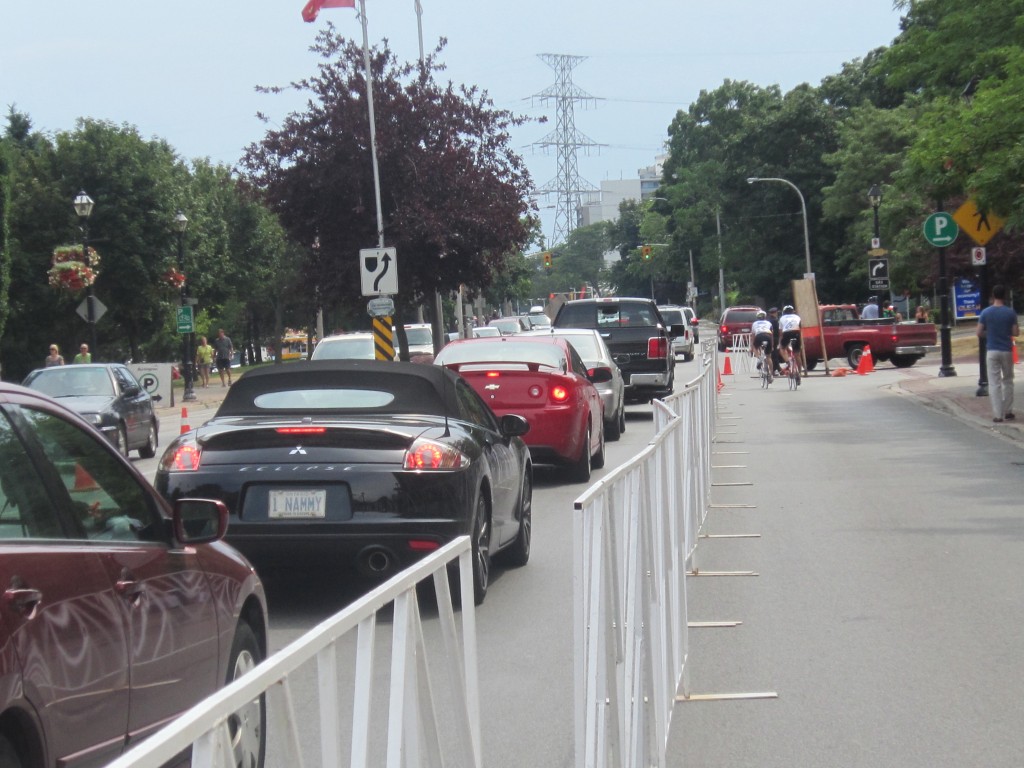 Traffic barriers in place on Lakeshore for the Car Free Sunday last year were expensive and not really used. The event was poorly attended. So they began to see if they could make it happen on their own and soon realized that they would need funding from the city – to the tune of $10,000 for two events – one that would take place on Appleby Line Sunday June 9th and the other on Palladium Way in the Alton Community June 23rd.
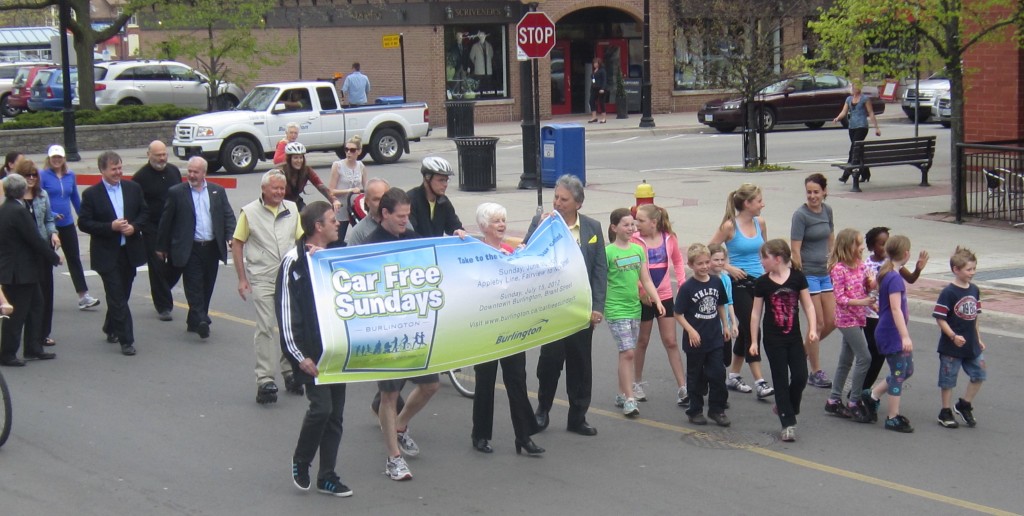 No problem spending a bundle on Car Free Sundays last year – but 2013 was going to be different. Councillor Meed Ward wanted Council members to pony up some of the cost from their expense accounts. Didn’t happen – but she did try. These three Musketeers, Councillors Sharman, Lancaster and Dennison, then asked their fellow Council members to join them in voting to “Authorize the Director of Finance to transfer up to $10,000 from the Tax Stabilization Fund to an account in support of Car Free Sunday.
Not so fast piped in Councillor Taylor. You can use the Tax Stabilization Fund for a one time expenditure. This is your second kick at the can – can’t use that fund.
 The Appleby Line Car Free Sunday was better attended than the one on Brant Street several weeks later – but neither event was a huge success. That wasn’t going to stop Councillors Sharman, Dennison and now Lancaster from giving it another go. Ooops said the three Musketeers. Councillor Meed Ward wasn’t part of this initiative but did say she would support the effort if each of the Council members used some of the $9000 expense account to support the effort. Lancaster didn’t like that idea but did say she would use $500 of her expense money and might go up to $1000 if she had to. Meed Ward then turned to Councillor Dennison to see what he was prepared to put up. Dennison wanted none of that and he bobbed and weaved and did everything he could not to answer the question.
Councillor Craven, who was also not involved sat there smirking for a while and then pointed out that there was an event in Aldershot that was getting his community into this type of thing incrementally. There was going to be a “Jane’s Walk in Aldershot May 5th and he would support the motion if they would add in $500 for the Aldershot event. That would bring Craven on board and give the group the four votes they needed.
Because this was a sort of Parks and Recreation project members of Council asked Parks and Recreation director Chris Glenn if he could fund this. Nope – I’m broke was the gist of Glenn’s answer. And besides he added – this is more of a Transportation matter. The “buck” was being moved from department to department.
Councillor Taylor thought he had a solution. “You must have more than 10,000 reserve funds – just take $1 from each and pay for this that way.
Still no takers.
 General manager Kim Phillips saved the day for the three Council members who wanted to promote a pet project and have the city pay for it. She found $10,000 that wasn’t being used. General Manager Kim Phillips did observe that the Executive Budget Committee noticed Councillor initiated events were ending up as projects that “you expect us to take on.”
Phillips, always ready to be helpful, suggested there was some money in the Strategic Plan Implementation Fund that wasn’t spoken for – would that help. Now getting a Car Free Sunday event defined as part of implementing the Strategic Plan is a stretch – but they did find a way to stretch this one by saying that it would contribute to Vibrant Communities which is one of the Strategic Plan pillars.
But before they got to that point in the discussion, Meed Ward pointed out that when there was a role for the city in Councillor driven events, some of the funding could come from the individual council member’s expense account and she went back after Councillor Dennison and asked again how much of his expense money was he prepared to put into the project. She almost had him.
But then he Mayor said: “We have much bigger fish to fry this evening” and Dennison added “let staff find the money”.
Blair Lancaster moved the motion – they had the four votes they needed – and so there will be two car free Sundays in the city – one June 9th and the other June 23rd.
Now you know how Burlington works. Meed Ward did hold their feet to the flames.

 By Staff By Staff
OAKVILLE, ON – Halton MP Lisa Raitt, Minister of Labour and the MP for Halton, has spread the largesse she hands out into the city of Burlington. Parts of northern Burlington are within the Raitt riding where she announced that the Region will benefit from improvements to roads, water and wastewater infrastructure. Tremaine Road will be widened and realigned which is a plus for Burlington given the development for the intersection of Dundas and Tremaine that is working its way through our Planning Department
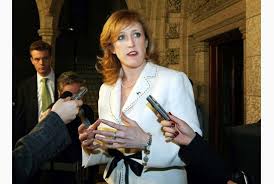 Halton MO Lisa Raitt told Regional officials that funding from Ottawa would show up in the Region. Parts of northern Burlington are in the Halton constituency. A new Regional water quality laboratory in Burlington, will get paid for out of the Gas Tax Fund. Given the way gas prices rise – we should see quite a few dollars from that source.
The federal government now has a new Building Canada Plan described as the largest investment in job-creating infrastructure in Canadian history. The improvements to local roads and waste water infrastructure that the government announced today are expected to have a significant economic impact here in Halton Region.
The Gas Tax Fund is supporting numerous projects throughout Halton Region. Between 2006 and 2014, Halton Region will receive more than $84 million from the Gas Tax Fund to improve local infrastructure. For example, Tremaine Road, a project that previously received $5.3 million from the Government of Canada through the Infrastructure Stimulus Fund, is now receiving an additional boost from the Gas Tax Fund.
 Water quality testing will be done at the Skyway Plant currently undergoing upgrades. In addition, at least $1.4 million of Halton Region’s Gas Tax Fund allocation is being put toward a new Regional water quality laboratory. This lab, part of the expansion and upgrade of the Skyway Waste water Treatment Plant in Burlington, will be built to test samples of drinking water, waste water, bio-solids and industrial waste from across the Region. Located in the new operations centre, it will help ensure Halton Region continues to meet and/or exceed water quality and environmental protection standards.

 By Pepper Parr By Pepper Parr
BURLINGTON, ON March 19, 2013 Ward 2 Councillor Marianne Meed Ward was the only Council member to come up with very specific suggestions on how to reduce the spending, which she feels is creeping outside what this city can afford. While Meed Ward doesn’t bring to the table the depth and understanding of municipal budgets that other council members have, and she doesn’t have anything in the way of a financial designation, she does know how to add up the numbers and she doesn’t think this city has to spend what it plans to spend.
Meed Ward would reduce the human resources merit fund from 1.5% of the HR budget to 1%. Savings: $157, 000
Meed Ward would eliminate the E-gov facility rentals. Savings: $165, 000
Meed Ward would eliminate the Risk & Consulting services. Savings: $909, 000
Meed Ward would eliminate additional leadership training; she argues there is already $500,000 in the budget. Savings: $80,000
Meed Wards wants the Brant House Museum to find the $7,000 they wanted for part-time curatorial services within the 2% increase they were given. Savings: $7,000
Meed Ward wants to take out the sum that was set aside for the Burlington Arts Centre foundation board restructuring. Savings: $100,000
Meed Ward didn’t want to give the Performing Arts Centre any more money. Savings: $488,000
Meed Ward, who doesn’t sit in the Burlington Economic Development Corporation board wants to reduce the BEDC ask to $160,000 from $370,000. Savings $210,000

Is she right? She is certainly worth listening to. She argues that “some of the spending increases are hidden because they are “onetime” funding not counted in the tax levy, and result from raiding our Tax Rate Stabilization reserve fund drawn to the tune of almost $2 million.”
What we saw this budget session was a tougher Meed Ward. Her view seemed to be that ‘if you can`t show me real savings and that you are going to do things differently – then I don`t want you to have any more of the taxpayers money.’ With that tone she is certainly playing the kind of music her people want to hear. She is a politician and she fully intends to be Mayor of this city – sooner than many in this city are ready for. My guess – it`s not a bet yet – within five years.
Let`s look at the specifics of what Meed Ward wanted to cut.
Merit pay: The city allocates 1.5% of the human resources budget as an amount managers can allocate to deserving employees as merit pay. Some of the people at city hall do a superb job and deserve an additional reward; that`s how you keep good people. The finance department has been doing a great job. That 1.5% is not given to every employee – it is allocated by the managers – some may get 2.4% while others get nothing. It is merit pay which the city manager will sign off on – fully expect Jeff Fielding to ensure that the merit pay is merited. Meed Ward wants to cut that 1.5% of the human resources budget back to 1% of the HR budget. That won`t be popular with staff but the voters will like it – is it good financial stewardship? It`s not bad.
E gov facilities: The city currently has three full-time people working on what is called E-gov; an approach that uses technology to get information out to people and to get information from people and to provide services faster, easier and more cost effectively. The city has yet to tell its E-Gov story. There is no space at city hall for these people – so the city went looking for a place to house them, found what they needed for the next three years and budgeted $165,000 to cover the rent. Where did Meed Ward expect these people to work – they need an office, preferably one that is heated.
Risk consulting: The city’s audit department is beefing up how the city manager checks on how money was spent. It is one thing to say we are going to have Results Based Accountability – but someone then has to go into each department and look at the projections and the results and report on if the objective was reached and if not – why. That stuff doesn’t just happen; there are procedures and processes that are put in place and followed.
The city manager is making the city hall bureaucracy much more professional – and that does not come cheaply.
Three people were brought in and will be added to the staffing compliment over the next three years. Why not put them all on staff now – that would mean upping the staff count and the city doesn’t want to do that.
Staff training: The city manager realizes there has to be a huge cultural shift at city hall. Doing things the old way is no longer working. People who work in the municipal sector are a product of the business they are in. Don’t expect them to do things differently; that’s not the way the business works and Fielding understands that, which is why he entered into an agreement with McMaster to have them train city hall staff. The 200 men and women taking these courses, amount to an Executive MBA with one fifth of the classes focused on municipal administration. Meed Ward thinks the city manager should make do with the $500,000 he was given. Is she right? On this one – she would be wiser to go with the request. The city will get, is already getting value and that will only increase. The down side is that Burlington is probably in the process of training people who will move on to other municipalities. We will be the best-managed city in the country and the place that everyone poaches to get first class staff.
 The Museum got the $7,000 they wanted – but it was an abuse of process making that happen. And the museum needs a lot more than $7,000 to do justice to the role Joseph Brant played in the development of this country. Brant Museum. Meed Ward opposed the $7,000 the Brant Museum wanted for part-time curatorial. Many felt Councillor Craven abused the delegation process by asking his colleagues to make an exception and have Burlington Museums Executive Director Barbara Teatro plead for the funds – which she got. The Brant Museum needs a really hard look in terms of the job it does researching and promoting the story of Joseph Brant before it gets any additional funding. Craven pulled a fast one and got away with it.
The Burlington Art Centre is going through a very tough stage. They have, in the recent past, had to turn to the foundation and draw down funds from them to meet operating costs. The foundation currently has a meager $35,000 on hand – not a healthy place to be.
The BAC Board and the Foundation Board were once one and the same – they have been divided into two separate boards which is how most places set these things up. The Foundation is usually the fund raising arm; the BAC board handles governance and oversight.
The BAC knew that it had to better define its role in the community. It is getting harder to capture any mind share with all the competing demands for attention. The creation of the Performing Arts Centre took away a lot of the attention the BAC used to get.
They asked the city for $125,000 and wanted to put $50,000 of that into the foundation as a reserve. They wanted to use the rest of the money to put together a marketing/business plan as well as a branding program that would set the BAC apart from other cultural institutions in the city.
They got $100,000 in one time funding to do what they’ve explained they feel they have to do.
Meed Ward doesn’t feel their funding should come from the taxpayers – she doesn’t seem to appreciate that the Art Centre is there for the taxpayers. The city might be dipping into the reserves – that’s what reserves are for.
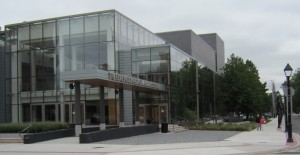 The Performing Arts Centre was never supposed to make money – the public just wasn’t ready for the place to lose as much as it lost or to need as much to stay alive. Performing Arts Centre: Meed Ward was one of the Council members that did not attend the Official Opening of the Performing Arts Centre. She has an understanding of the way the place should work that many don’t understand. Her view is that the professional events brought to the PAC have to pay their own way and at the best of times earn enough to leave funds available to support the community events, the non-profit groups that were supposed to be making great use of the space.
Meed Ward wants the profit-making types to subsidize the non-profits. She doesn’t think the PAC needed money to pay for an additional technical person – the increased business would cover that cost and if there were no increase in business then the PAC wouldn’t need the additional technical person.
Meed Ward didn’t see any value in the additional sales associate. The amount they would be adding to the revenue side wasn’t worth the cost or the risk.
Meed Ward doesn’t bring an “artsy” view to the PAC. For her it has always been a nice to have but now that we’ve got the place she doesn’t want to see it sucking up all the funds the city has in reserve. On that one – she should have gotten more in the way of support from her colleagues. That the Executive Director resigned the day after the budget was approved messes up that situation somewhat.
Meed Ward is tough on what the PAC can and should do for the city. A more developed appreciation on the part of what the PAC can do for the city would help – but Meed Ward has a constituency and they like what she is saying.
 The city needs to see more photo ops like this. The business model the BEDC had in place was a close to total failure. It took a shock from the city manager who reported Burlington was going to experience negative commercial growth in the tax base for 2013 to motivate the BEDC board to do something. Meed Ward wants more information on how they are going to solve the problem before she approves funding. Council decided to give them what they were asking for. Economic Development Corporation: We now have Meed Ward who is a more involved Councillor on things economic, which up until now has not been one of her strengths. She still struggles with some of the concepts but she knows how to add and she brings the view of the average person to the table. For Meed Ward the “what” has to be done is no longer the issue – the city needs more jobs; the city has a great story to tell potential corporations looking for a place to locate and we have the economic land needed. That the land isn’t ready for occupancy is an issue that can be resolved. For Meed Ward, the issue is how we are going to do this and she doesn’t believe the BEDC has a grip yet on the how part and she doesn’t want to give them anymore funding until the “what” has been made very clear.
For her, and her constituency – it is pretty clear. The nuances that BEDC Executive Director Kyle Benham talks about are beyond the ward two council member. Those two are never going to agree on much but she has clout at the Council table – Benham approaches as a supplicant.
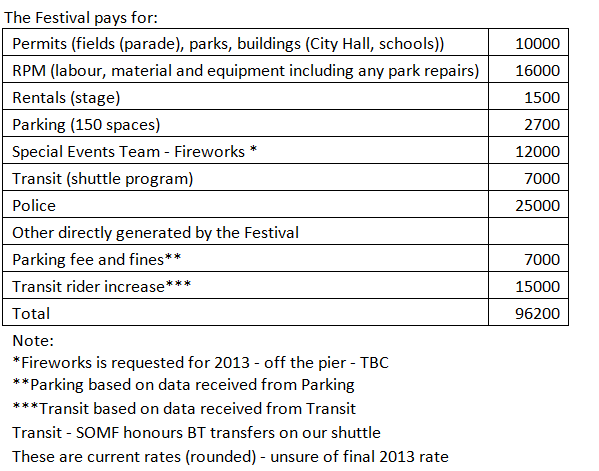 Meed Ward argues that the Sound of Music produces revenue for the city. The numbers in the right hand column are monies paid to the city for services the city provides – that’s SOM money being paid to the city.
Meed Ward says they pay the city $96,200 Sound of Music: Meed Ward isn’t afraid to spend money. She thinks the Sound of Music is one of the best deals the city has going for it and she was quite prepared to let them have the $37,000 they were asking for. She would be inclined to give them more if they asked and would love to see the Performing Arts Centre delivering economic benefits the way the Sound of Music does.
Meed Ward wanted to cut spending – that’s good, politicians have an ability to spend and try later to duck the consequences. Not this lady. Unfortunately some of the cuts she proposed were ill-advised and not thought out thoroughly. One of the problems is that Meed Ward antagonizes people; she pushes buttons and moves people out of their comfort zone. And so they push back. We saw Councillor Craven pushing back in a most inappropriate way.
Meed Ward is learning – and she does have the capacity to learn. No one is really sure who is advising her – she doesn’t have an advisor, a trusted confidant she can bounce ideas off.
She does have a constituency and they love her. How large is that constituency and can she grow it to the point where it will carry her to the point where she wears the chain of office. Too early to tell – but she gave them all a run for their money this budget session.
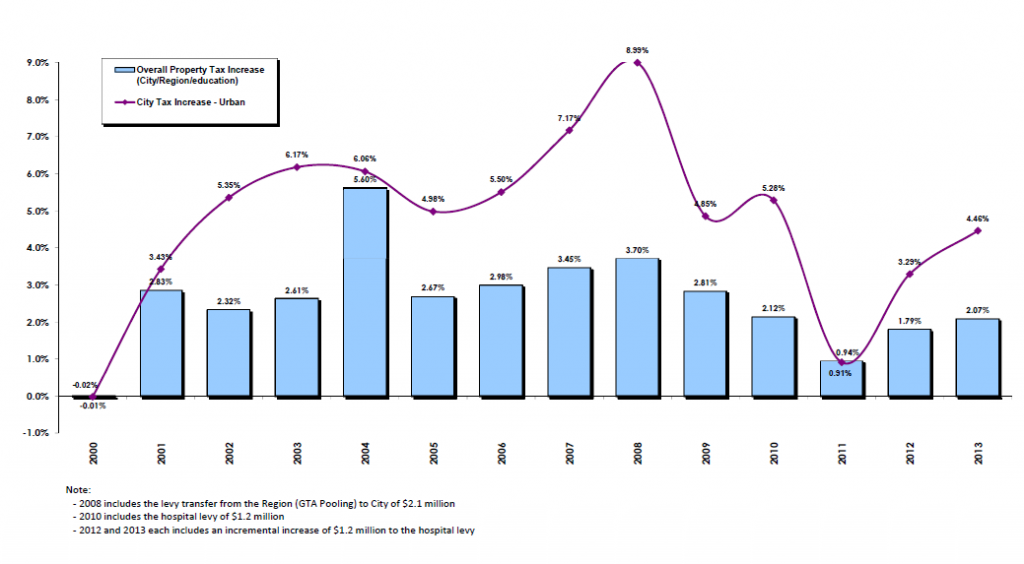 Meed Ward doesn’t like the direction the tax curve is taking and fears for the impact this could have on the seniors who have fixed incomes. She asks if the tax dollars are being spent in the right places. For Meed Ward it is all about the tax rate which she says has increased 60% in the past 10 years. The graph shown is not something she is proud of and not the kind of city she wants to run.

|
|

















 What was nascent and budding – has been stunted at the administration level.
What was nascent and budding – has been stunted at the administration level.











 The golf course wants to spend $150,000 this year on upgrading parts of the golf course – Dennison wanted to defer that spending while the city took a closer look at the property and the opportunity he felt it offered.
The golf course wants to spend $150,000 this year on upgrading parts of the golf course – Dennison wanted to defer that spending while the city took a closer look at the property and the opportunity he felt it offered. Were anyone to ask a privately operated golf course what their competition was you would expect them to tell you exactly how many competitors they had and be able to tell you which were their closest competitors in terms of course usage and revenue.
Were anyone to ask a privately operated golf course what their competition was you would expect them to tell you exactly how many competitors they had and be able to tell you which were their closest competitors in terms of course usage and revenue.

 This year there were 17 items from just two council members: Dennison and Taylor of ward 3 – both whom have been on council individually for more than 20years
This year there were 17 items from just two council members: Dennison and Taylor of ward 3 – both whom have been on council individually for more than 20years
 Marianne Meed Ward chaired the meeting – she runs a swift, no-nonsense meeting; this is a council member that has learned a lot in the four years she has served the city. Much more focused when it comes to running a meeting. As chair she gets to talk as long as she wants – and to the delight of her colleagues she has learned that 50 words can often do as much as 500 words.
Marianne Meed Ward chaired the meeting – she runs a swift, no-nonsense meeting; this is a council member that has learned a lot in the four years she has served the city. Much more focused when it comes to running a meeting. As chair she gets to talk as long as she wants – and to the delight of her colleagues she has learned that 50 words can often do as much as 500 words.




















 The objective of this project has been to report on the status of the city’s infrastructure, including adequacy of funding levels in the context of full life cycle needs. Following this, the project team would work with Finance staff on the analysis of funding scenarios and implications for the long-term condition of the city’s tangible capital assets.
The objective of this project has been to report on the status of the city’s infrastructure, including adequacy of funding levels in the context of full life cycle needs. Following this, the project team would work with Finance staff on the analysis of funding scenarios and implications for the long-term condition of the city’s tangible capital assets.

 Based on this analysis, the existing backlog of now needs for facilities and buildings is estimated at $13.2 million.
Based on this analysis, the existing backlog of now needs for facilities and buildings is estimated at $13.2 million.
























 Services Committee got through the high level overview in close to record time.
Services Committee got through the high level overview in close to record time.


 After all that “heavy lifting” at the Standing Committees the budget will go to Council for approval on March 17th.
After all that “heavy lifting” at the Standing Committees the budget will go to Council for approval on March 17th.

 Mayor Goldring is a member of LUMCO – a subset of the AMO organization made up of mayors from larger cities.
Mayor Goldring is a member of LUMCO – a subset of the AMO organization made up of mayors from larger cities.
 Burlington has a union contract with the firemen that has been ‘in the works” since 2011.
Burlington has a union contract with the firemen that has been ‘in the works” since 2011.


























